Part 8 of the story of the cruise "Go friends to warmer lands" on the ship "Rus Velikaya" to Kazakhstan: the first day in Kazakhstan.
In this post: we finally step on the Kazakh land, ride the Kazakh steppes, take a look at the Kapam-Sai canyon, visit the underground mosque of Shakpak-Ata, see the valley of the Torish stone balls and visit the T.G. Shevchenko museum in Fort- Shevchenko.
Photos will be many. Do not break the mouse wheel! :)
01. 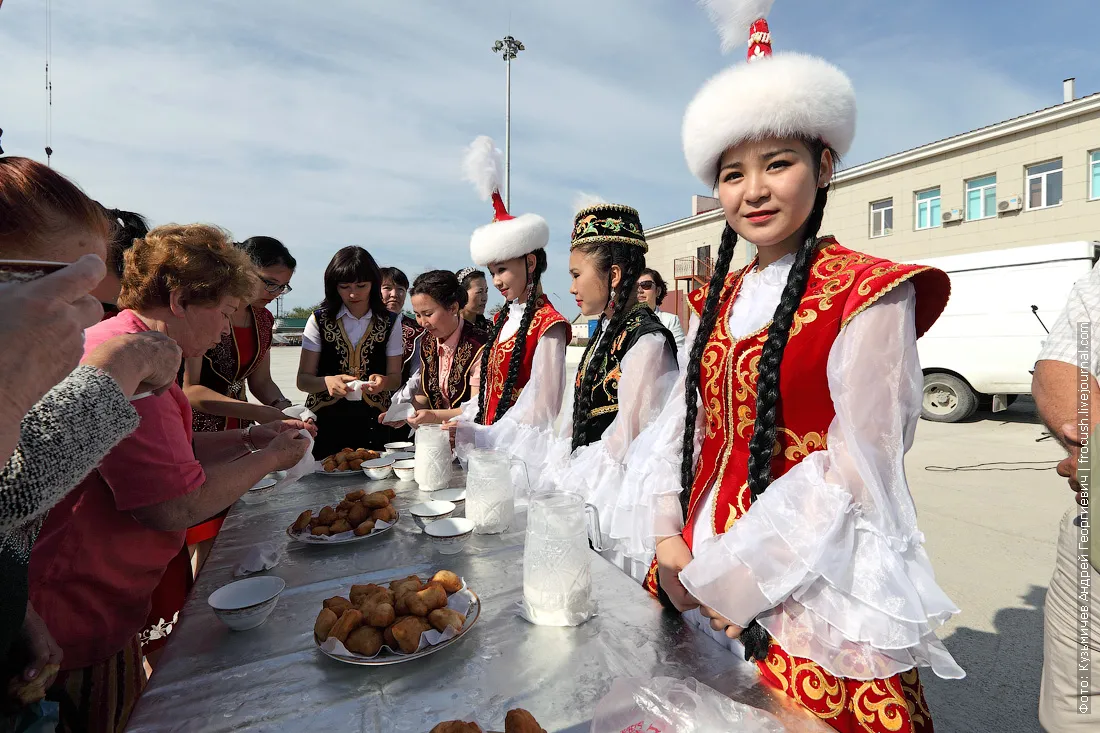
The first day in Kazakhstan began with a very early rise. 4:30 in the morning! But this is only on our watch, and local people are two hours more, and the Kazakh border guards who have penetrated into the wardroom of "Rus Velikaya" are waiting for the passengers of the ship to pass passport control.
In the photo: the morning shore of Mangyshlak peninsula and the ships at the raid of the port of Bautino.
02. 
Passport control does not take much time: you sit down to the Kazakh border guard, you give him the passport, the border guard looks at you, on the passport, photographs you, scans the passport, puts something on the computer. Everything, the next! Everything takes about two or three minutes. The main thing is to wait for your turn and sit down at the table to the border guard.
In the photo: we followed a guide - a local tug, which showed us the right path from the raid to the harbor of the port.
03. 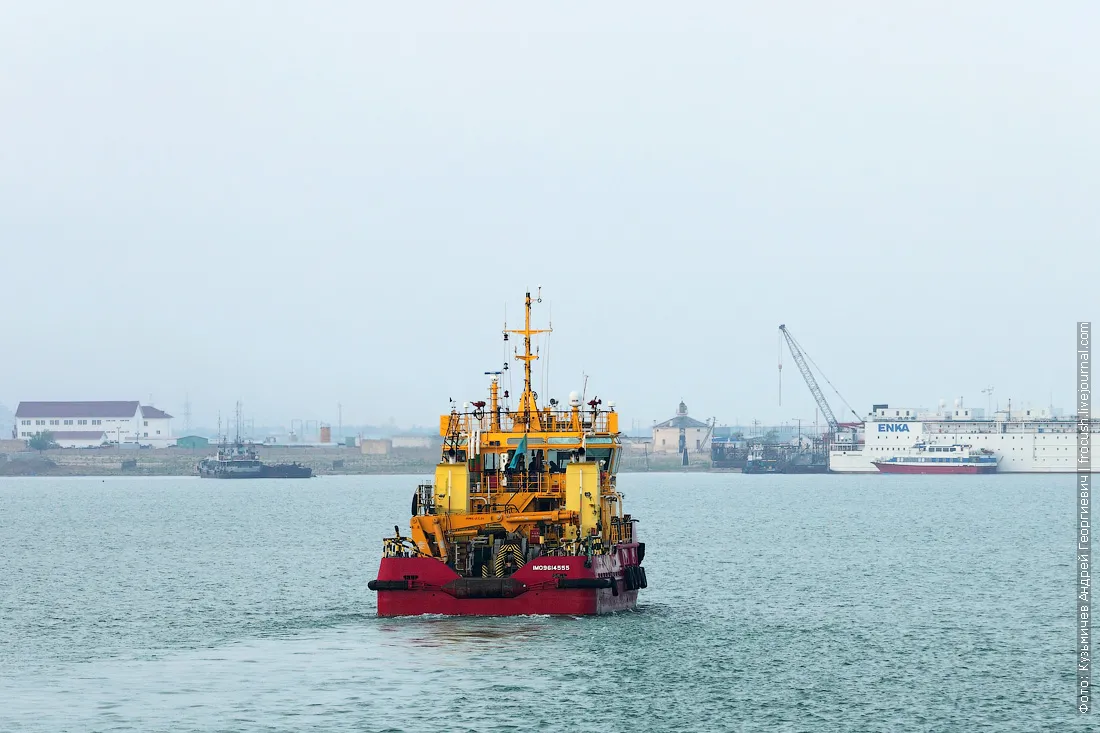
Early morning. The top of the rocky shore is still in a fog.
04. 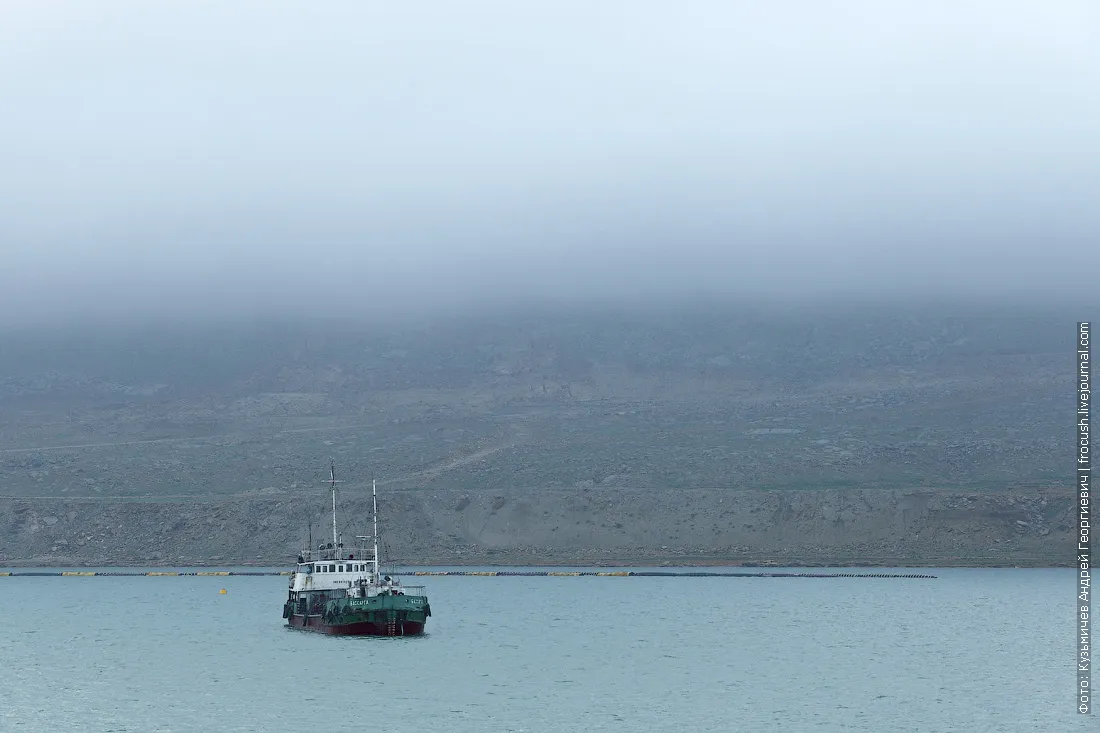
We go to the port "Bautino". The "Navruz" floating site for 400 oil workers.
05. 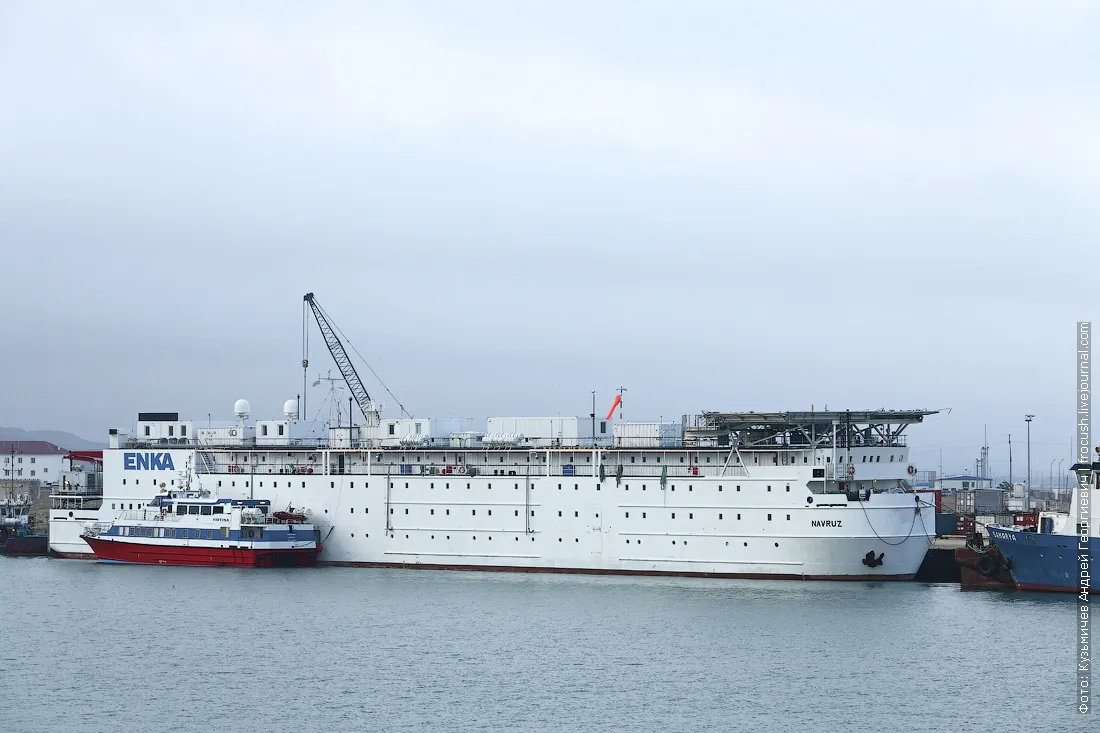
The sun rises over Kazakhstan. Now the morning fog over Mangyshlak will disperse!
06. 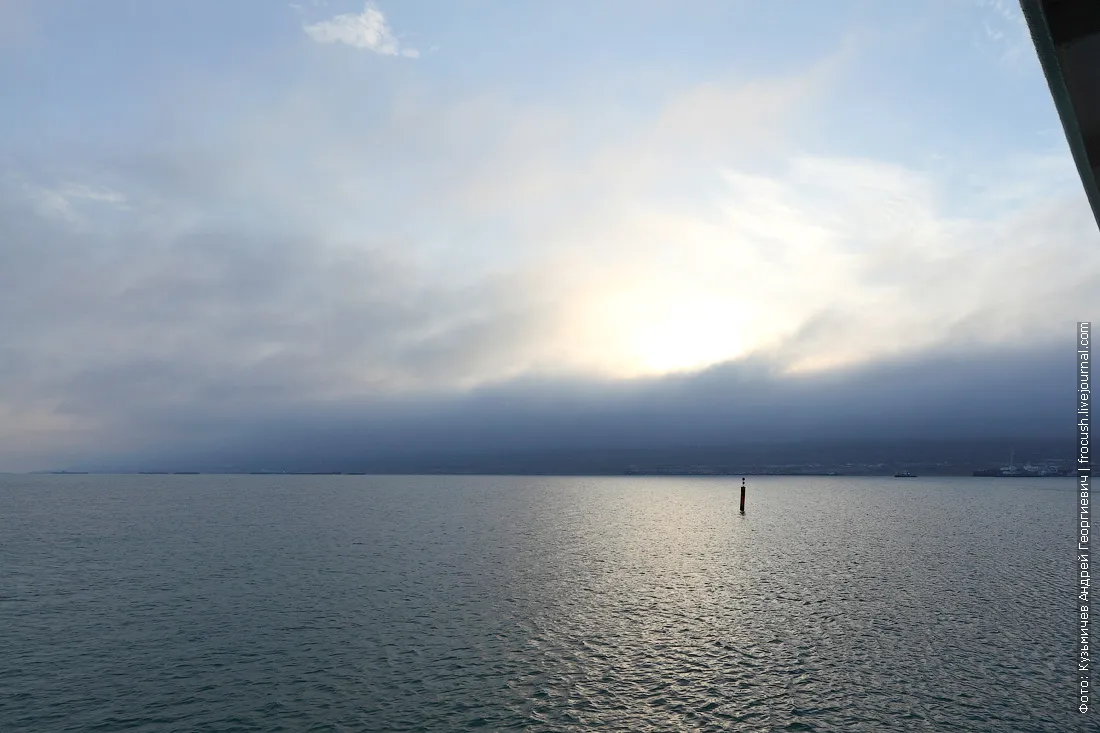
This photo clearly shows why you can not enter or leave the port in the dark. In the water area of the port, there is a mass of some shallows and flooded old gizmos. We had to carefully circumvent this, moving in intricate zigzags following the tug to the pier.
07. 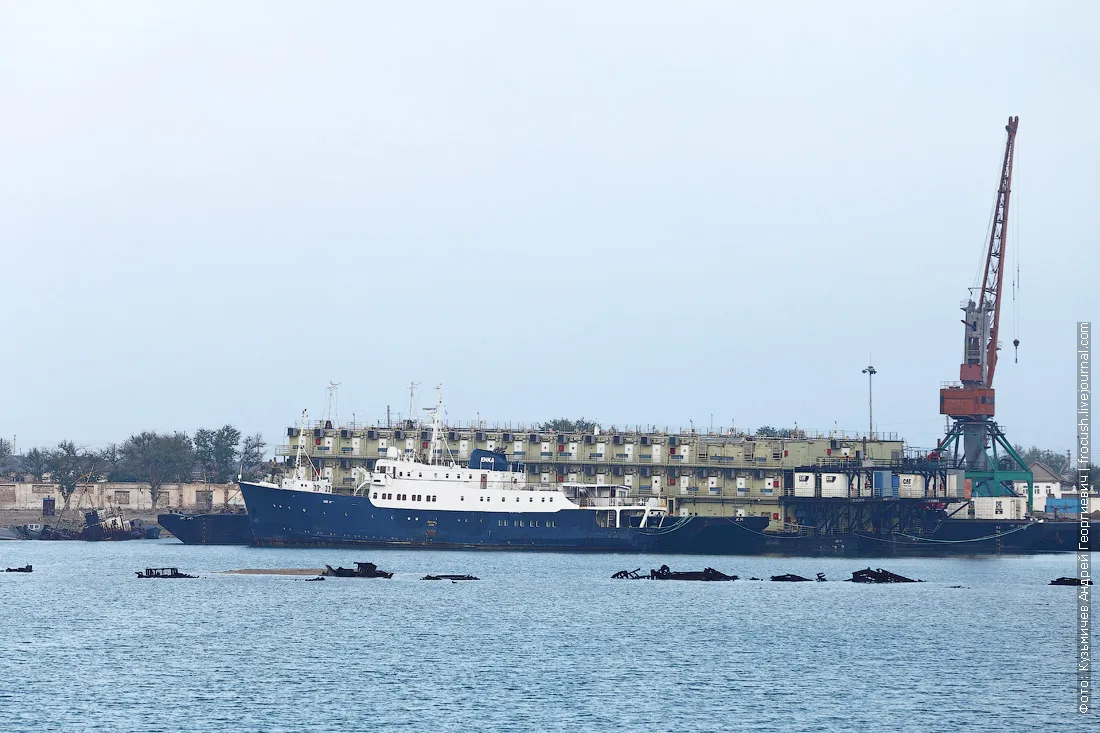
Almost arrived. The tugboat "Phoenix" departs aside, lets us go forward.
08. 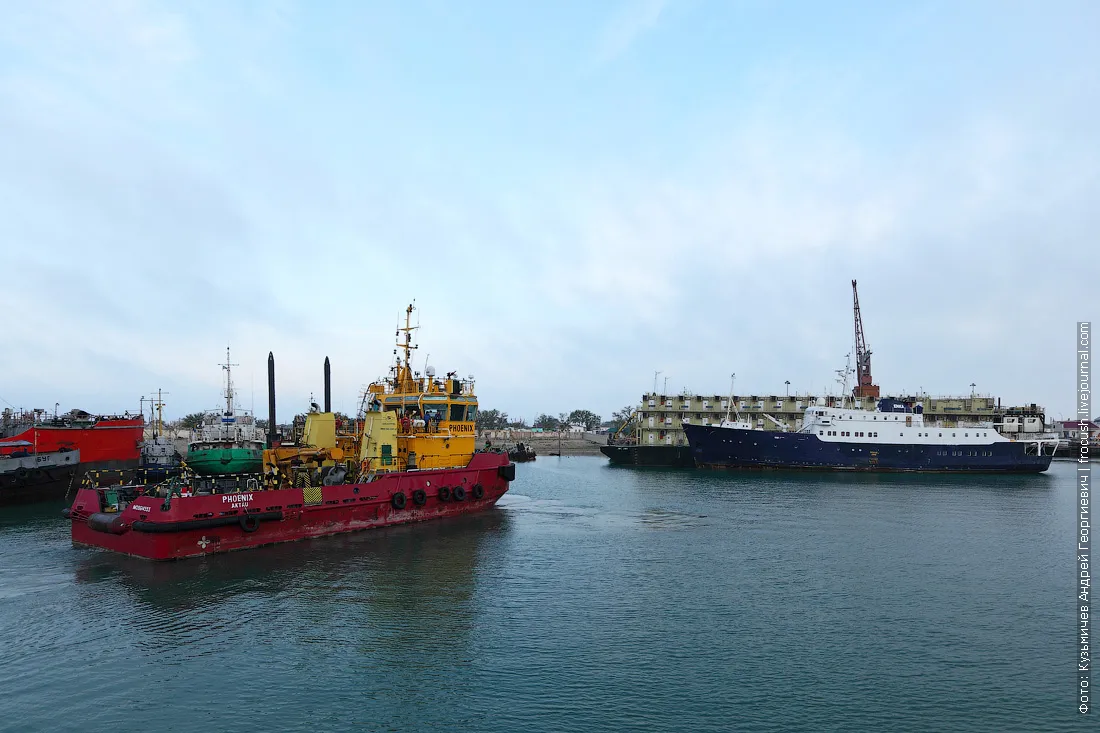
We pass by the next floating hostel and the passenger ship "Dicle".
09. 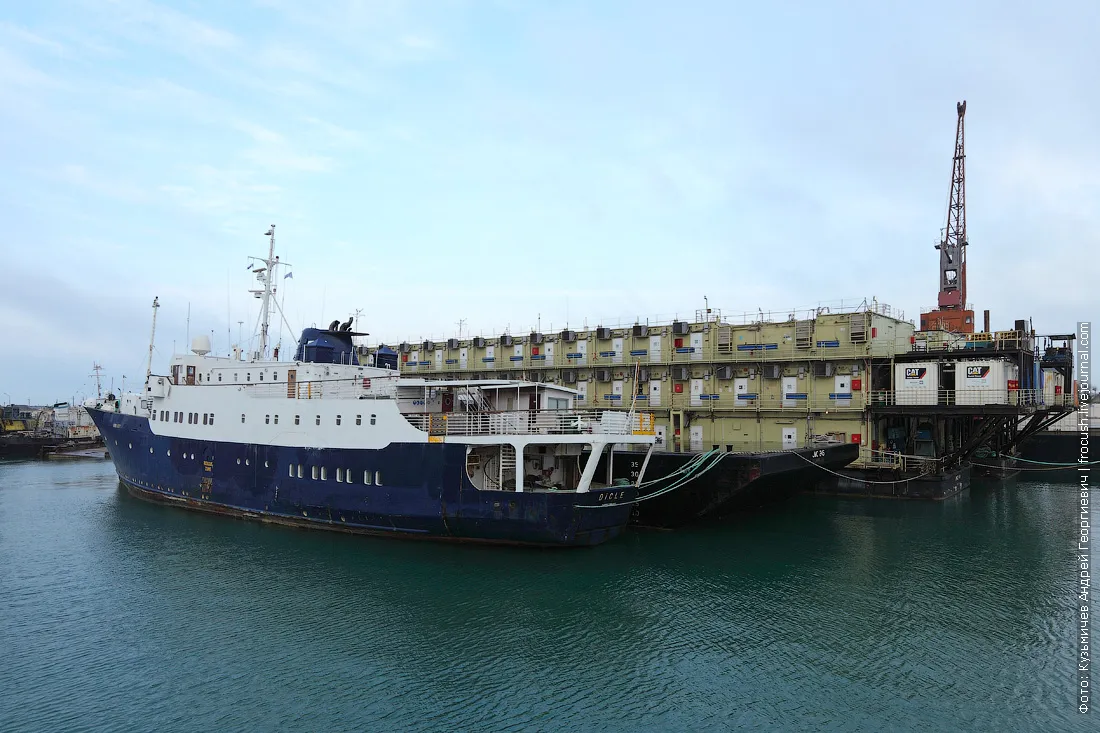
We neatly approach the pier.
10. 
We moor to the cargo berth of the port "Bautino".
11. 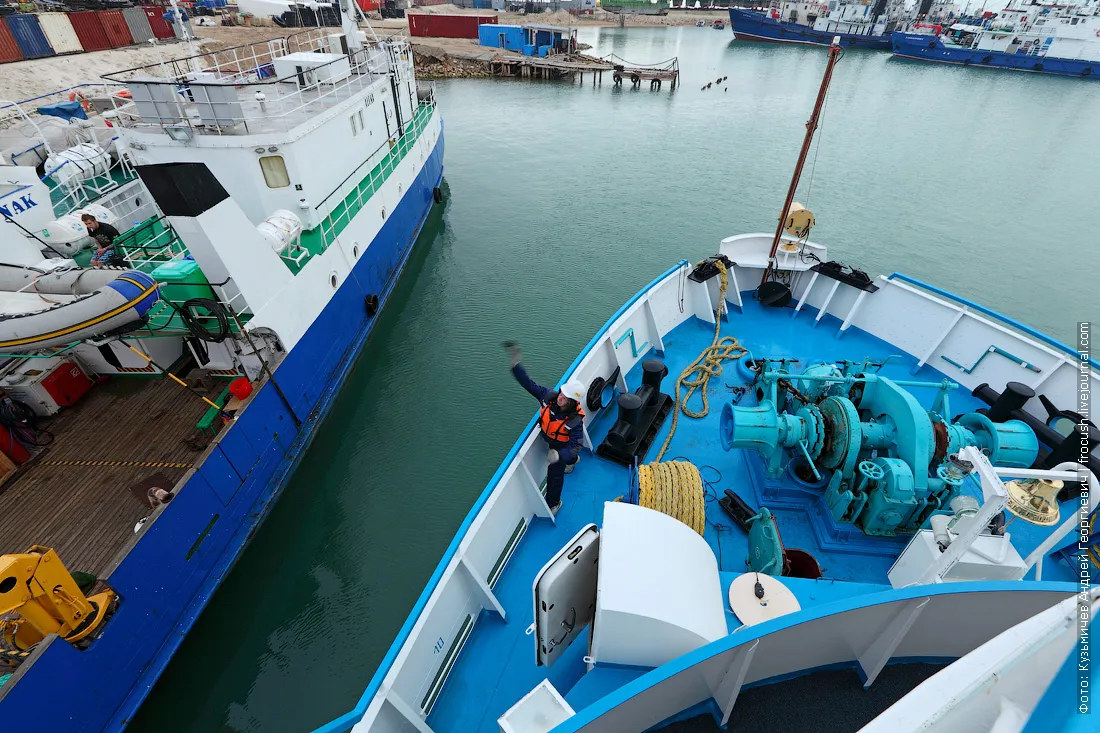
12. 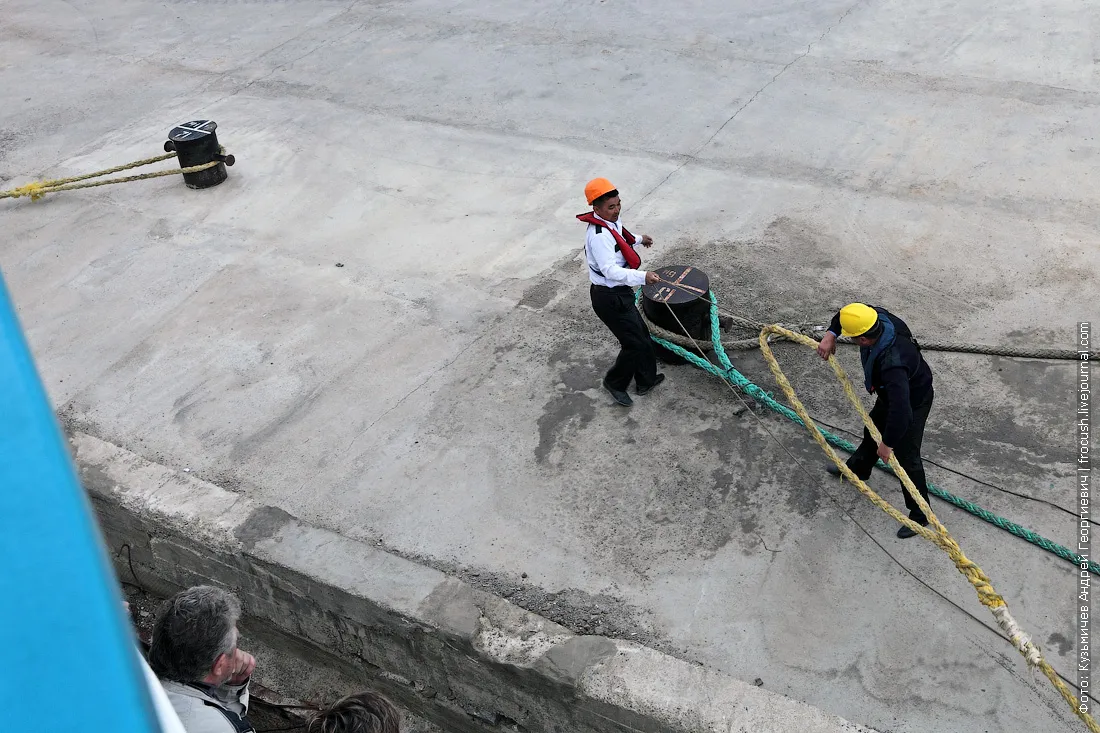
Yes! Immediately after the mooring operations the tugboat "Phoenix" approached us: some documents had been transferred from it.
13. 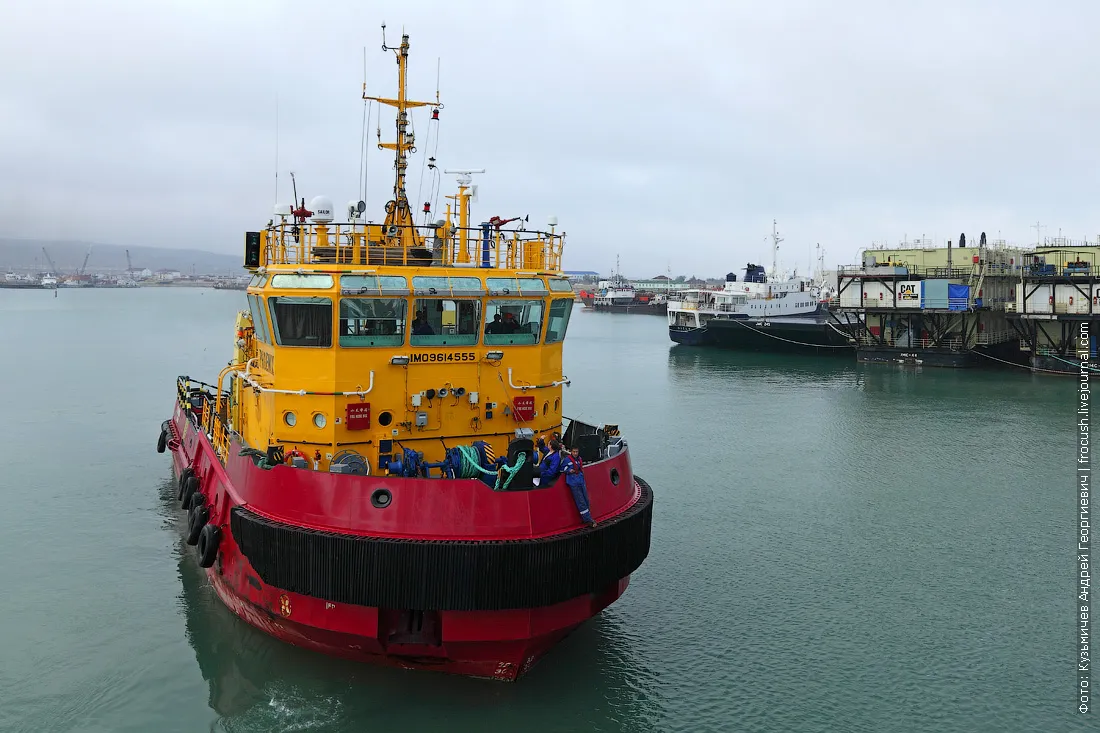
Ta-da-da-da, ta-dam! Hooray! It was done! Tourists of the ship "Rus Velikaya" go ashore in the Kazakh port "Bautino". By the way, you just can not get ashore. On the way out there is a Kazakh border guard and, checking the lists, checks the passport of the outgoing tourist.
14. 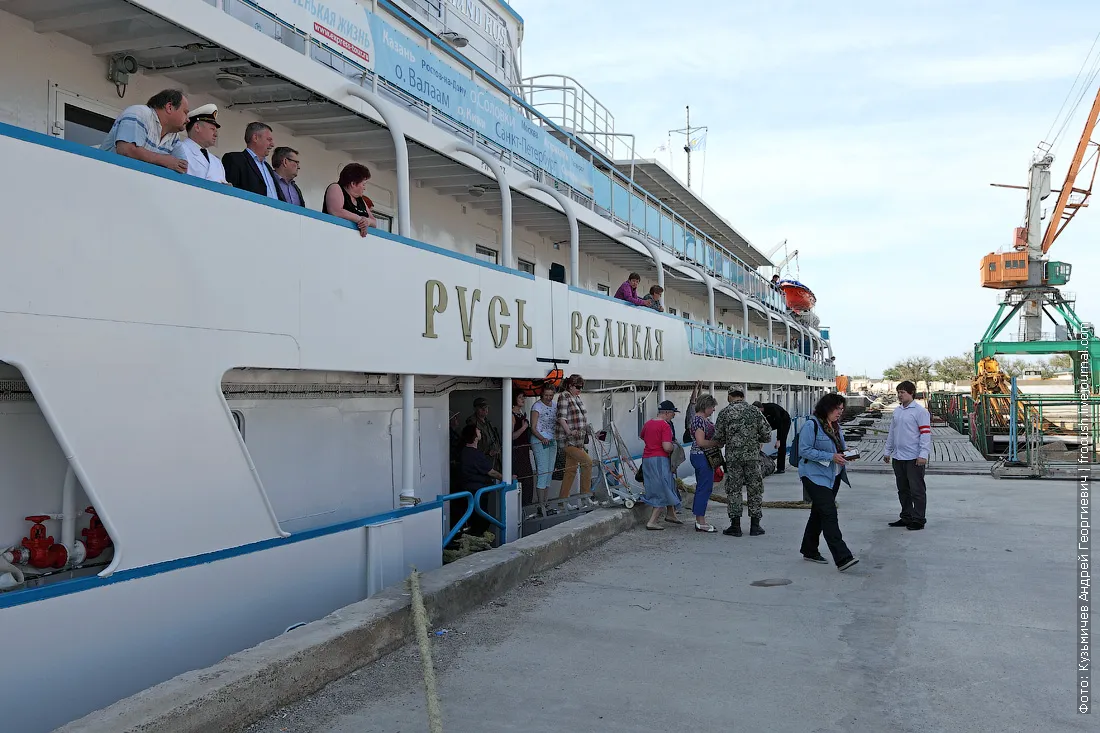
And what a wonderful meeting hosted the host Kazakh side the first in the history of tourists who passed through the Volga, crossed the Caspian Sea and arrived on a ship to Kazakhstan!
15. 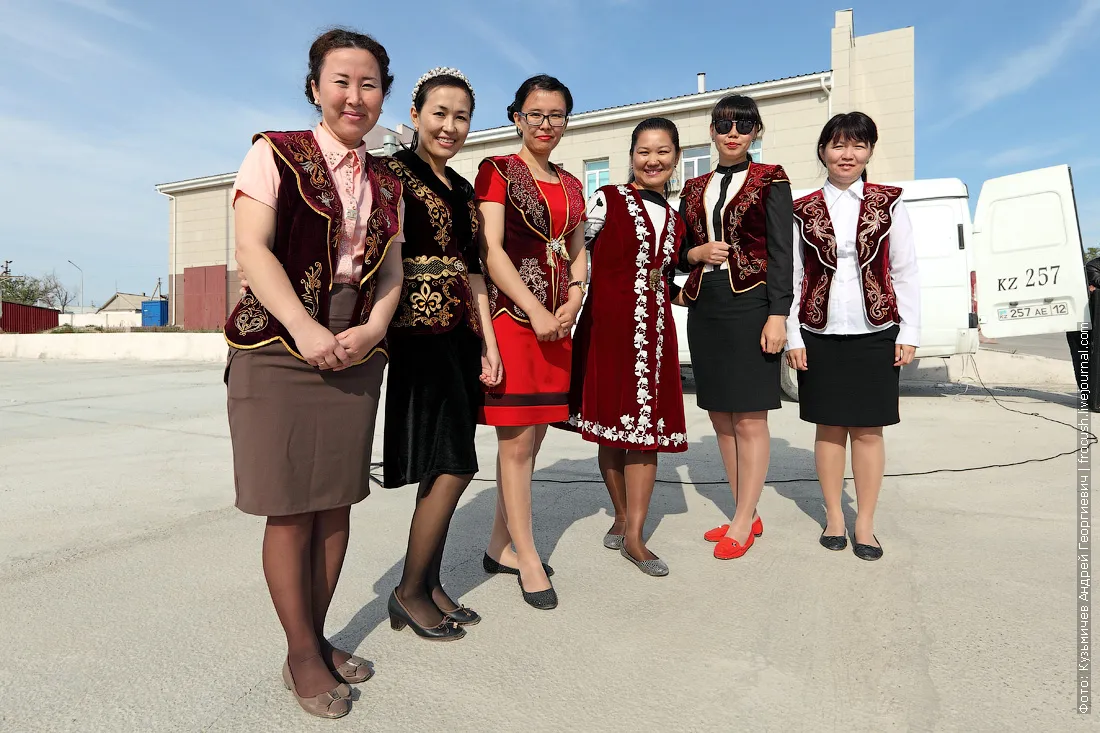
Girls in national Kazakh costumes treated us with local pastries and milk drinks.
16. 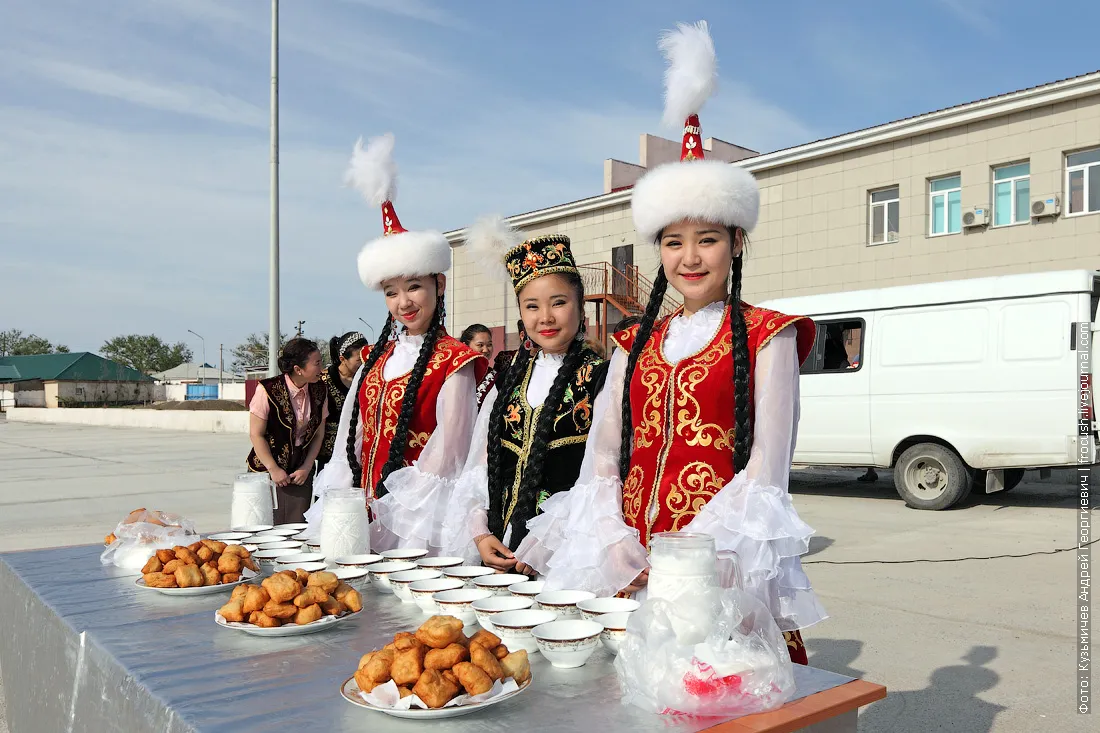
True, I did not try anything, only took pictures.
17. 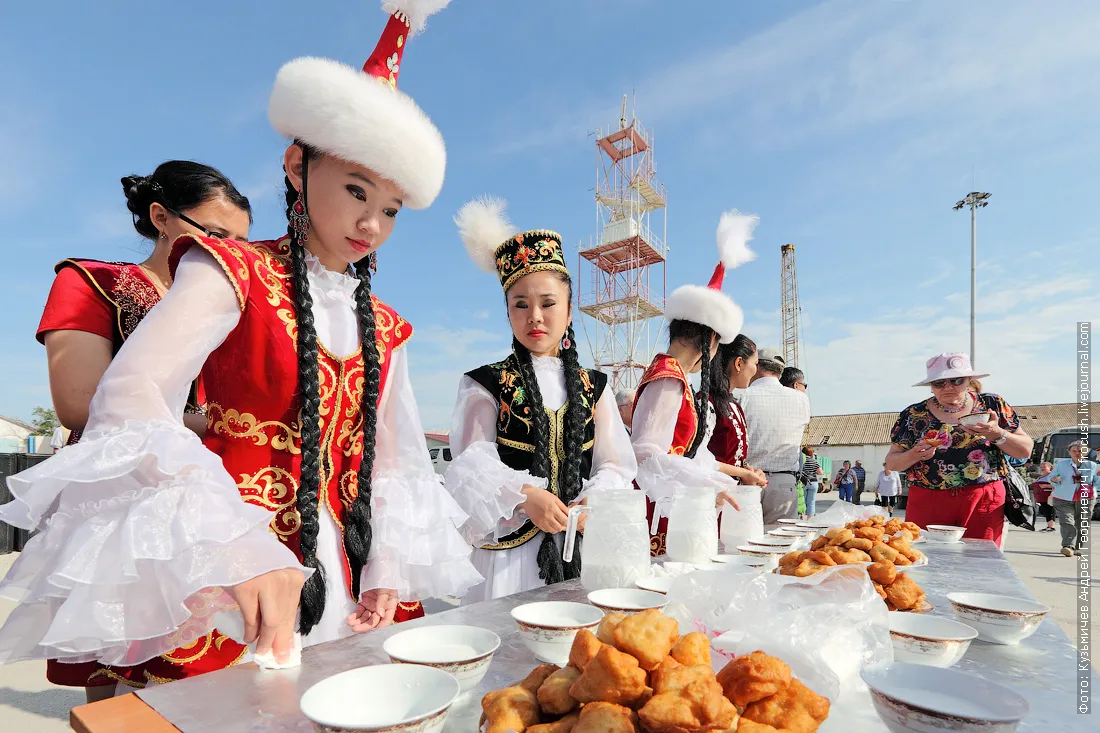
But other tourists liked treats.
18. 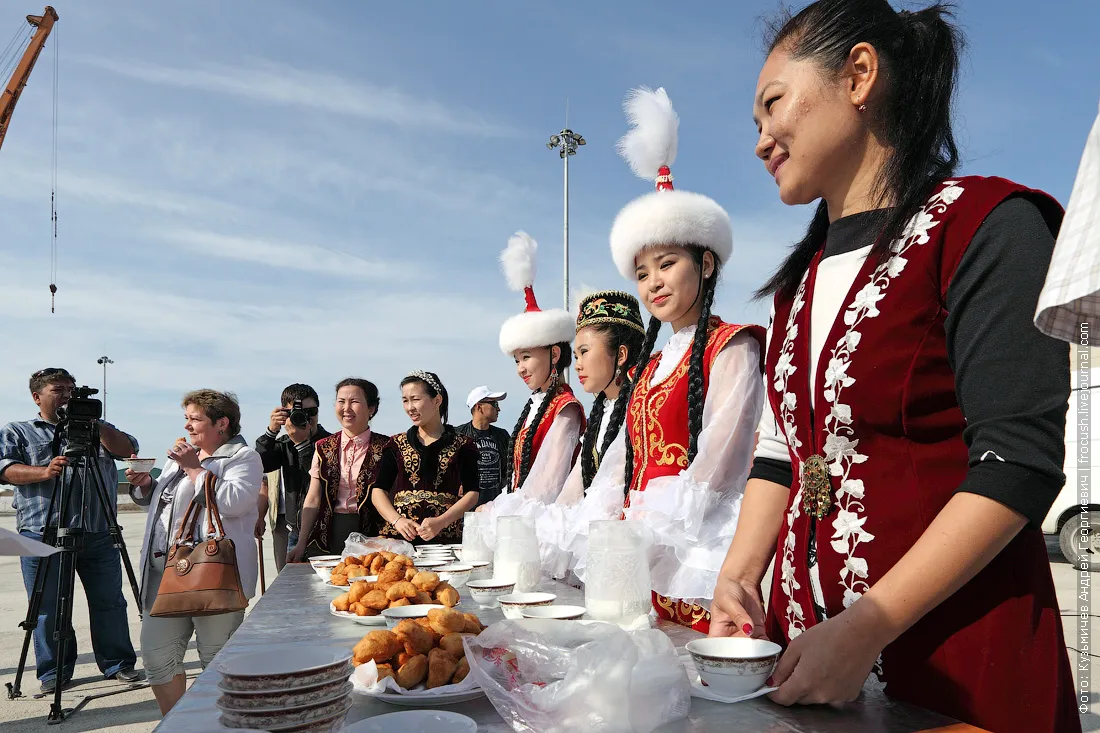
Almost everyone ate :)
19. 
Even Vadim treated himself and was quite satisfied :)
20. 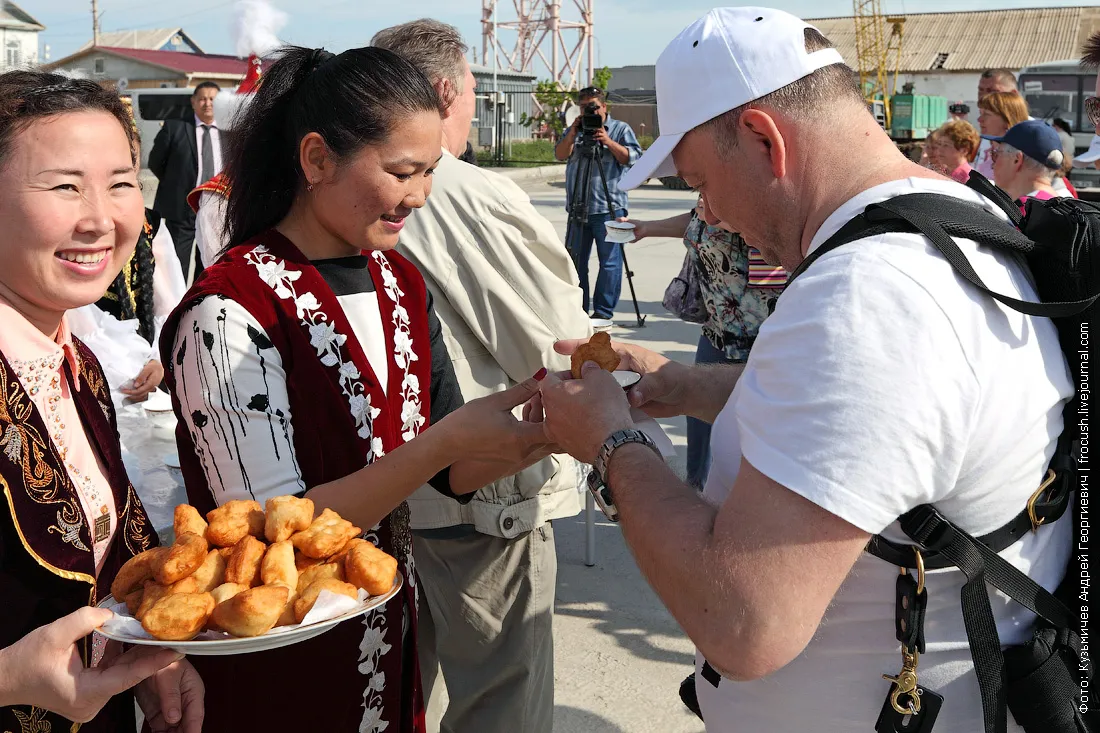
While tourists went ashore and dismantled the treats, welcome speeches sounded, and local journalists recorded all this in detail.
21. 
Who has not yet tried the treats?
22. 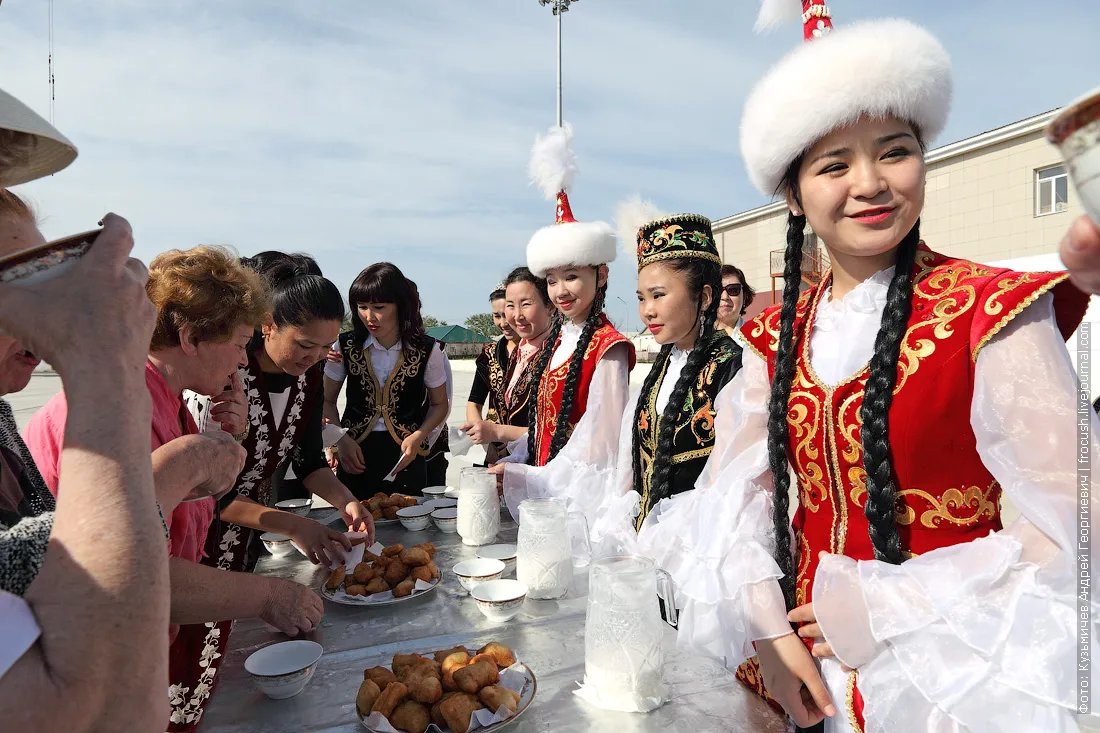
Beauties!
23. 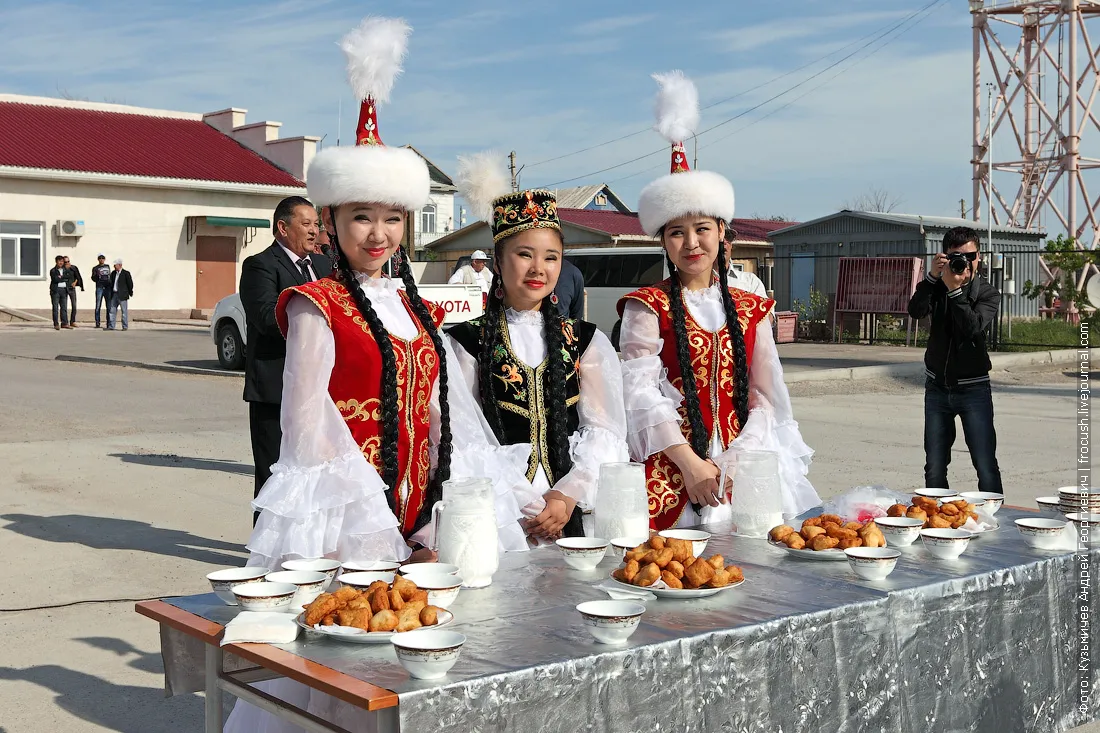
Not without individual gifts. The oldest tourist of the ship "Rus Velikaya" received a very interesting album with beautiful illustrations about the sights of the peninsula Mangyshlak.
24. 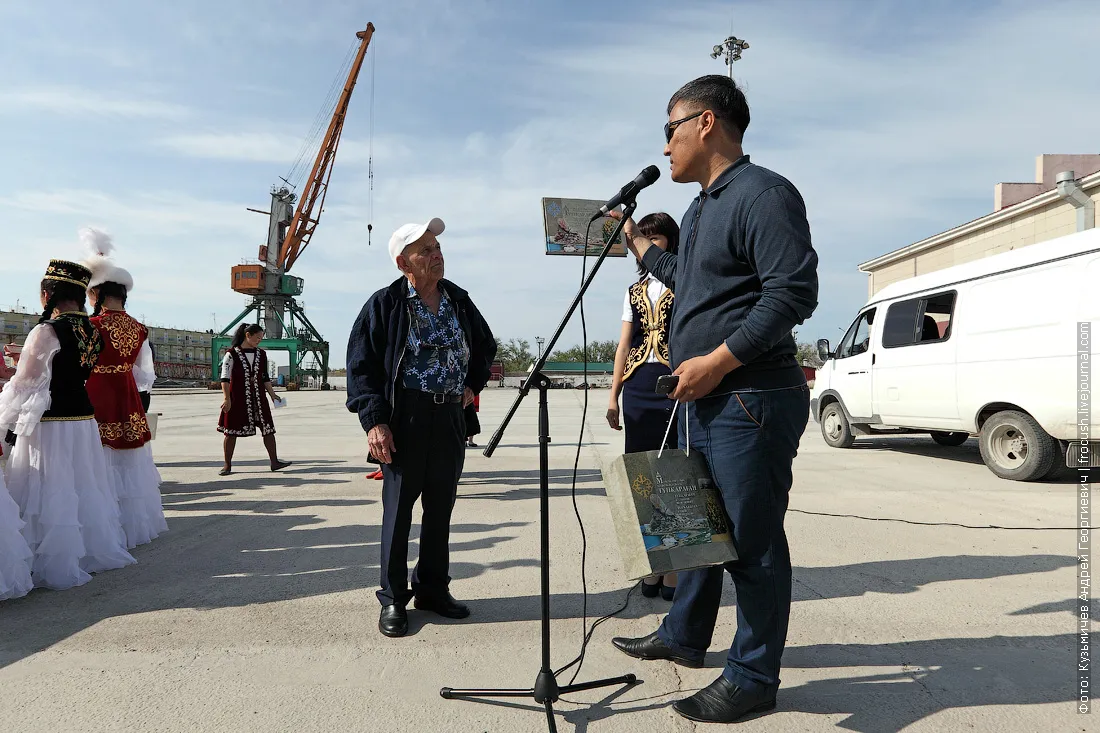
And the same album was given to a tourist who on that day celebrated his birthday (from here follows a small lifhak - go to cruises to celebrate your birthday: you are waiting for mandatory bonuses and gifts).
25. 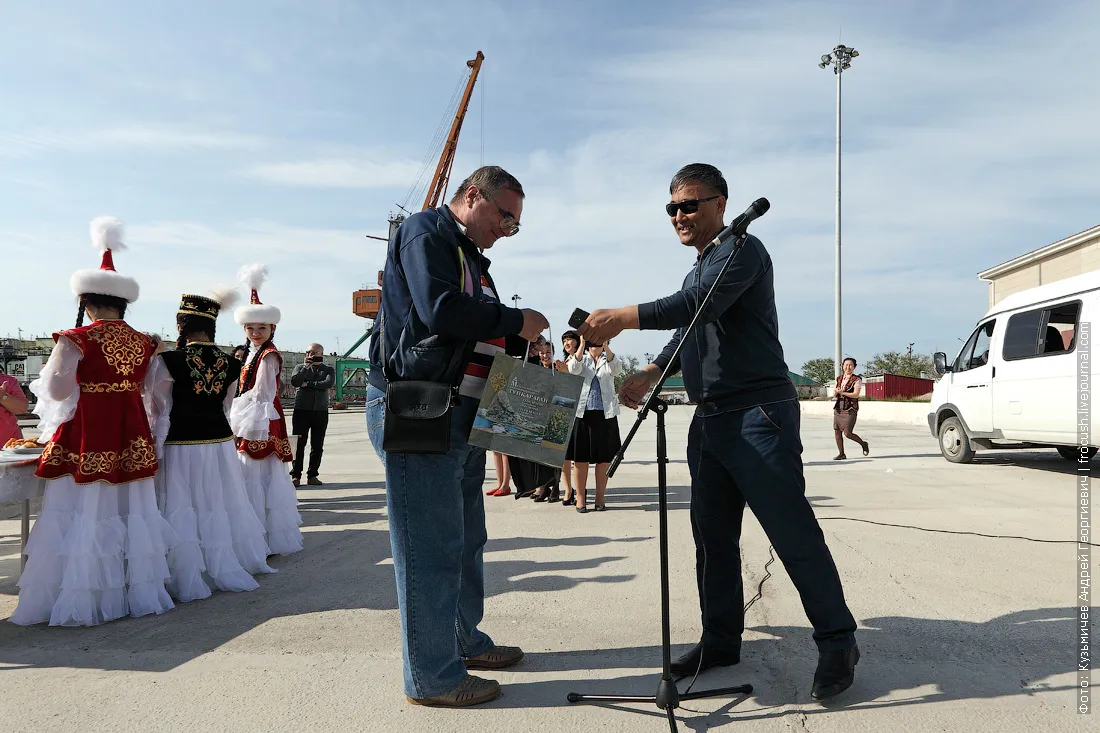
After a hearty meeting at the pier, we plunged into the buses and went to watch the Kazakh sights. The first attraction is roads, or rather their absence in the usual sense. If in settlements there are still asphalted roads, then turn off slightly to the side and everything - just rolled up "gravel" or just land. The main joke is that the sights of the peninsula are located away from the asphalt roads and it's necessary to get to them for a long time and following such rolled paths. Shakes with mercilessness. Go on an excursion to the sights of Mangyshlak - take a small pillow with you. Superfluity will not be :)
26. 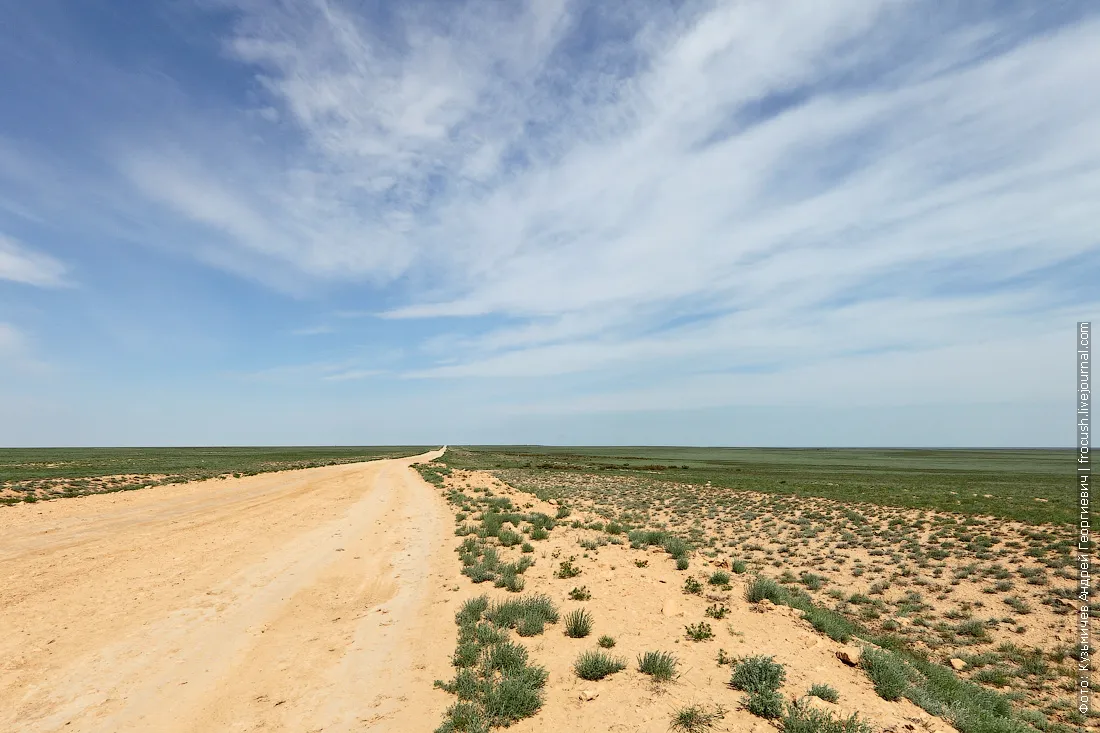
The Kazakh land.
27. 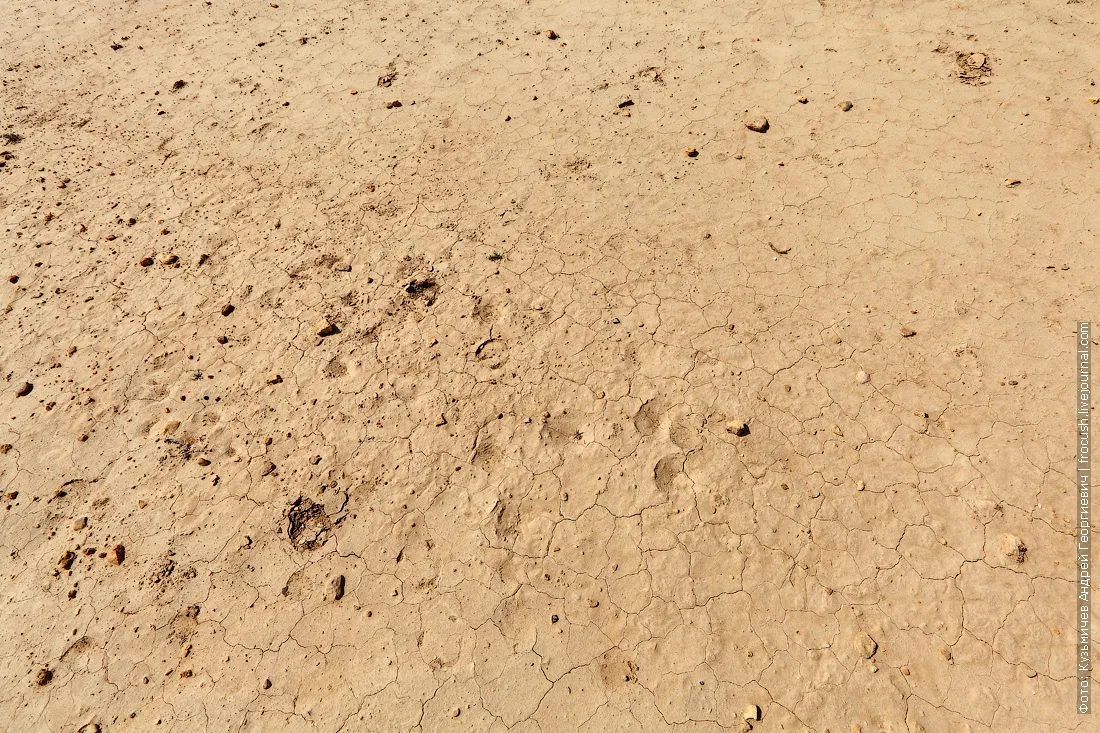
Three years there was no rain, but this April there was a lot of precipitation, and the steppe came to life (the local call it a desert).
28. 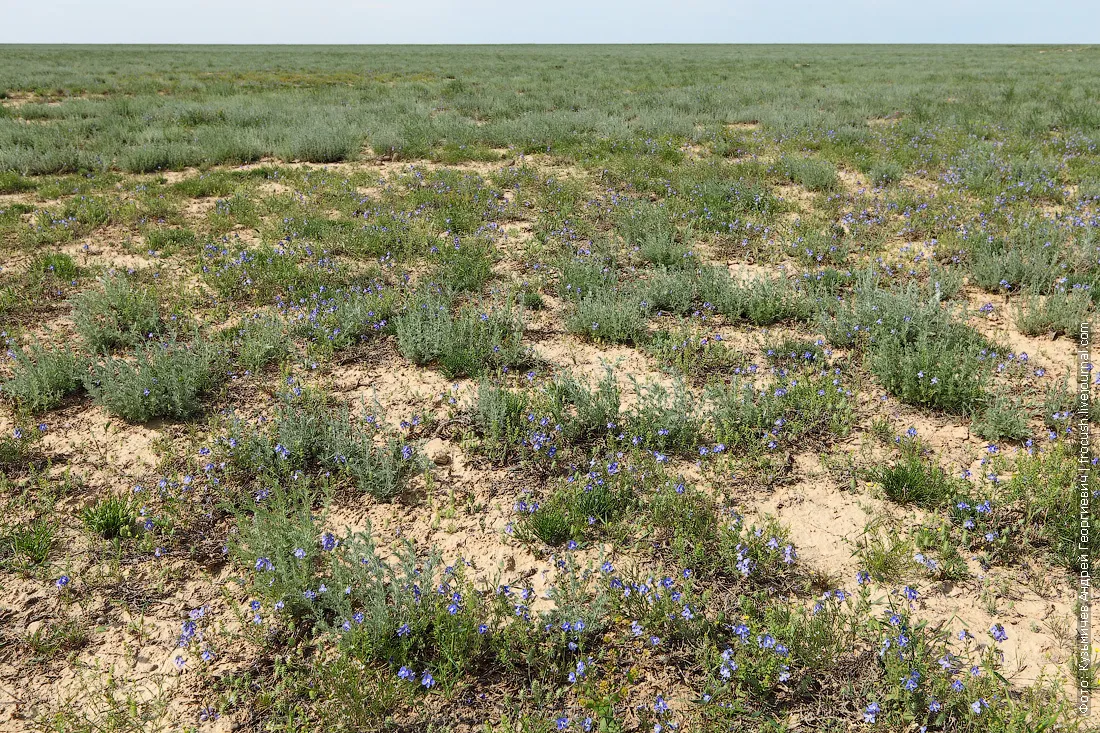
This is our first stop in the steppe. Tourists, sensing the smell of wormwood, immediately rushed to collect it.
29. 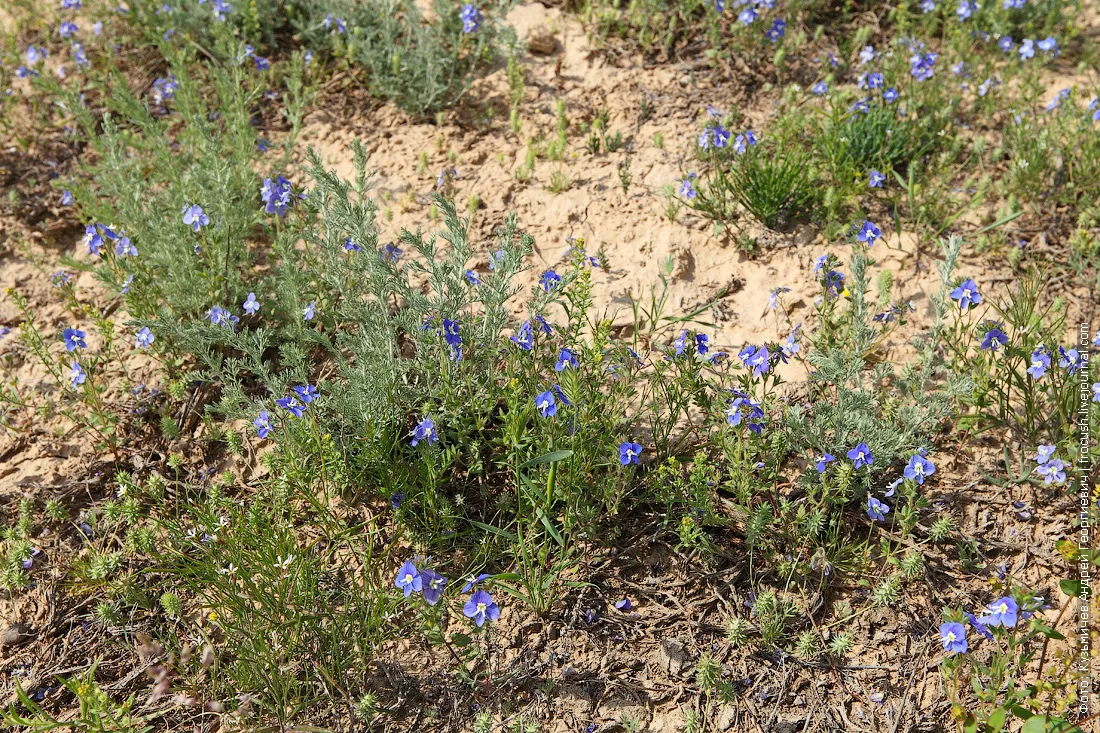
Rushed, but not all.
30. 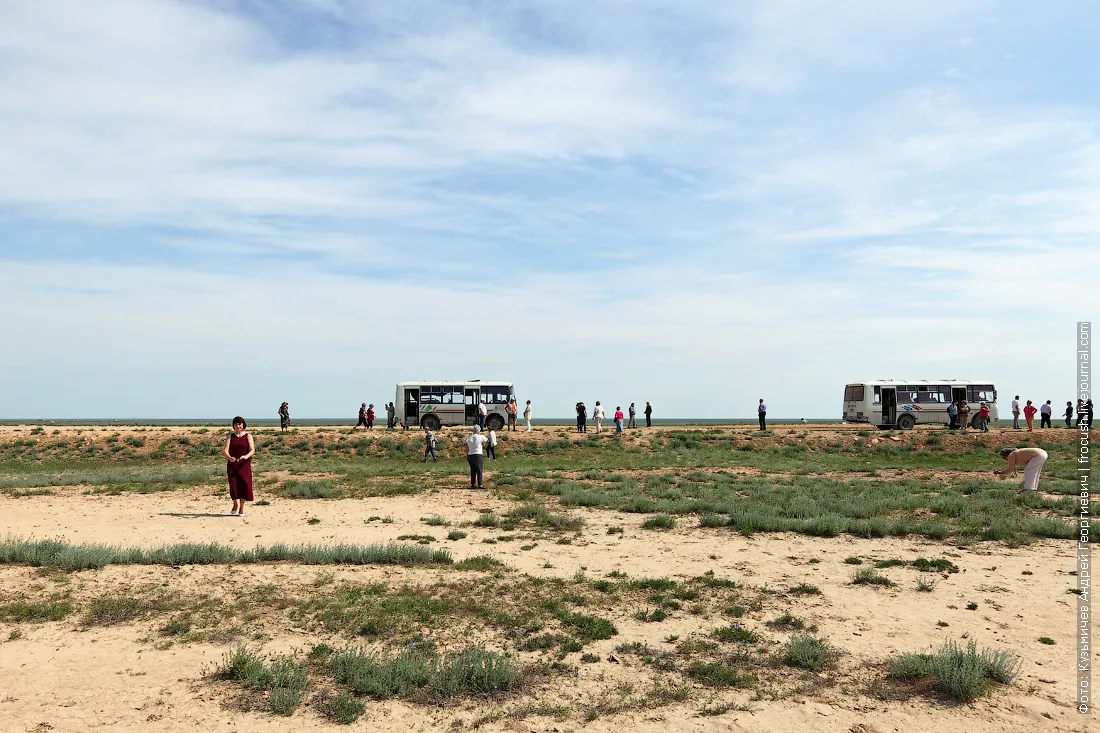
Someone, armed with a camera, began to be photographed against the background of the steppe Kazakh expanses. I liked photographing the steppe - it's easy to expose the horizon :)
31. 
And this is our excursion "PAZ". Yes, some tourists were outraged by this fact, they say, that for the garbage you brought us here, there were not any buses better? There are better (will be in the evening and on the asphalt), but not along these roads. For example, in this excursion we have to drive just 10 km along the asphalt, and the remaining 190 km along the road with a grader covering, and 36 km along the country road, which in some places consists of slides and ravines. Only "PAZ" here and cope.
32. 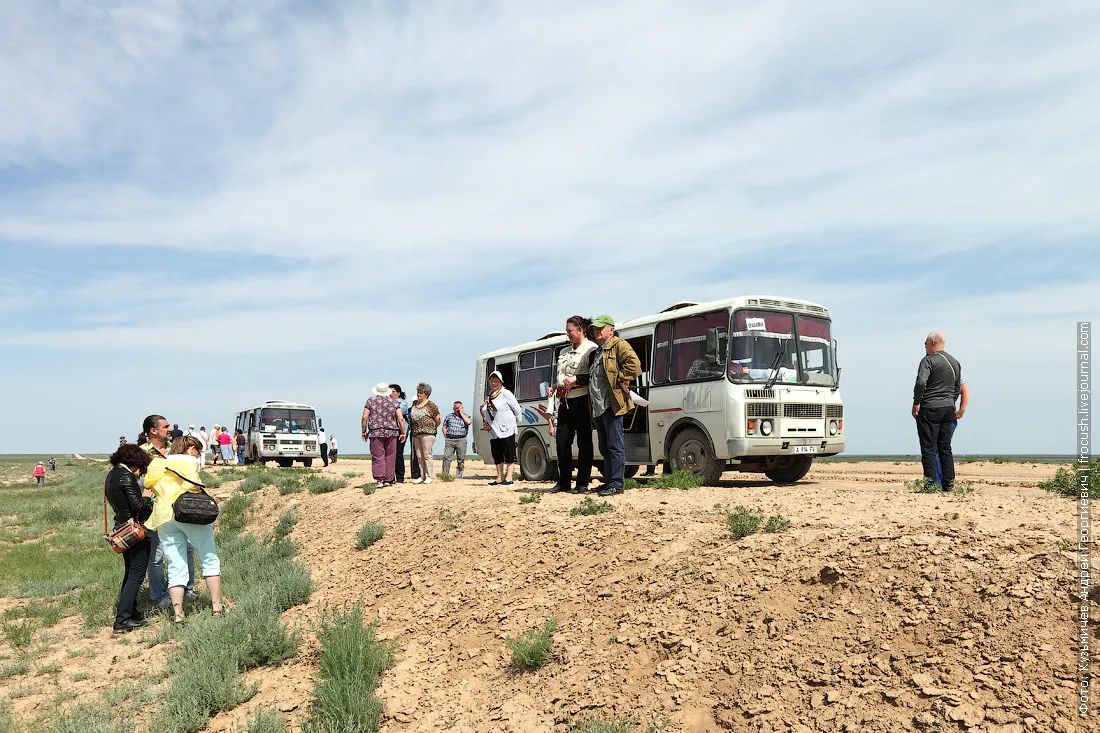
Not! What are they! "PAZ" is not a bus for them. Residents of Nizhny Novgorod, for example, every day on the "PAZ" skate and nothing, only with the flags sometimes go out.
33. 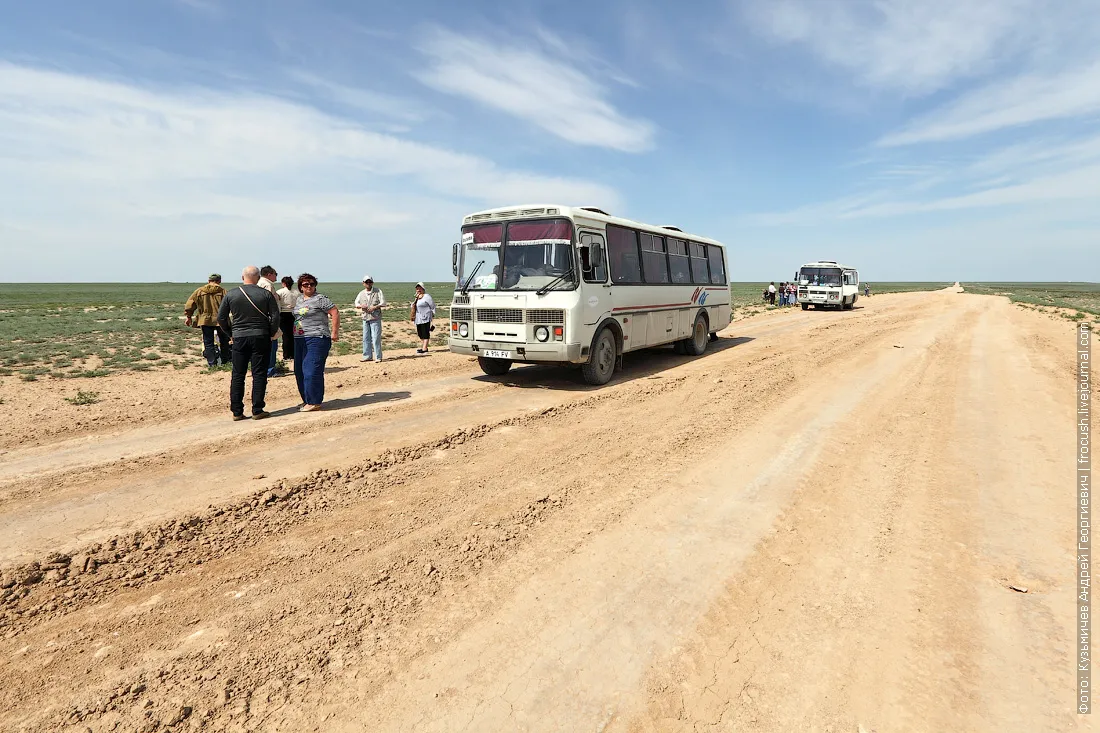
The next stop on our way is the narrow chalky canyon of Kapam-Say, whose even and steep walls reach 70 meters in height.
34. 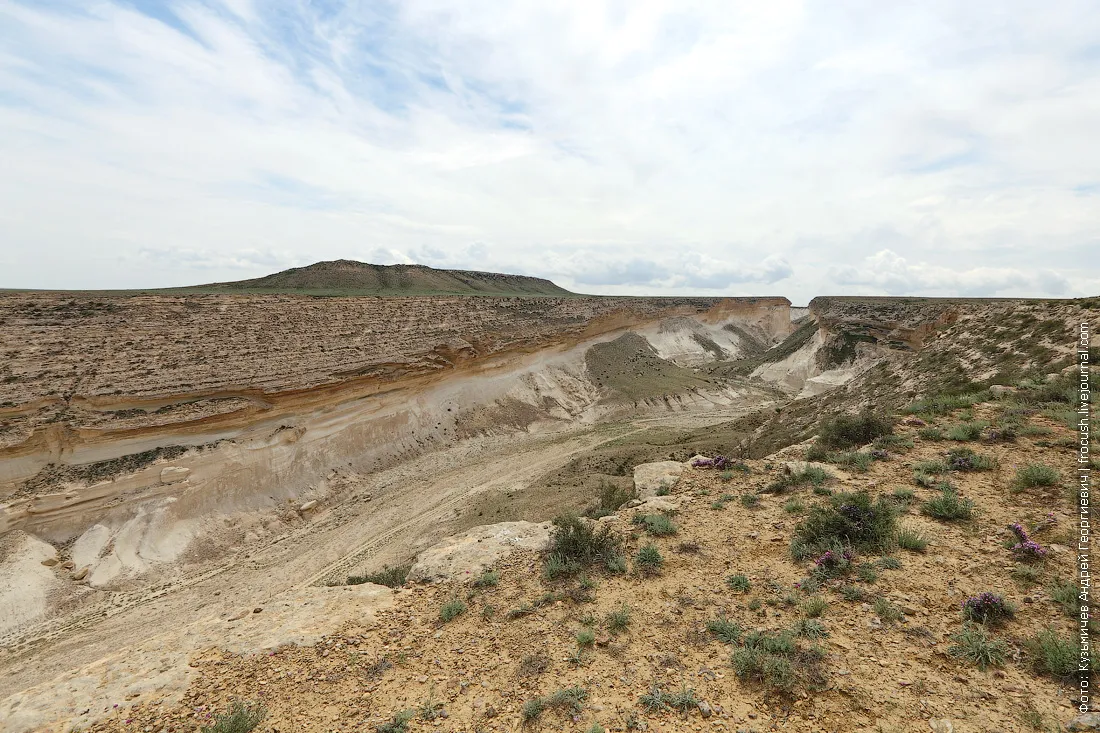
The canyon derives its name from the name of Sufi St. Kapam, whose grave is located here.
35. 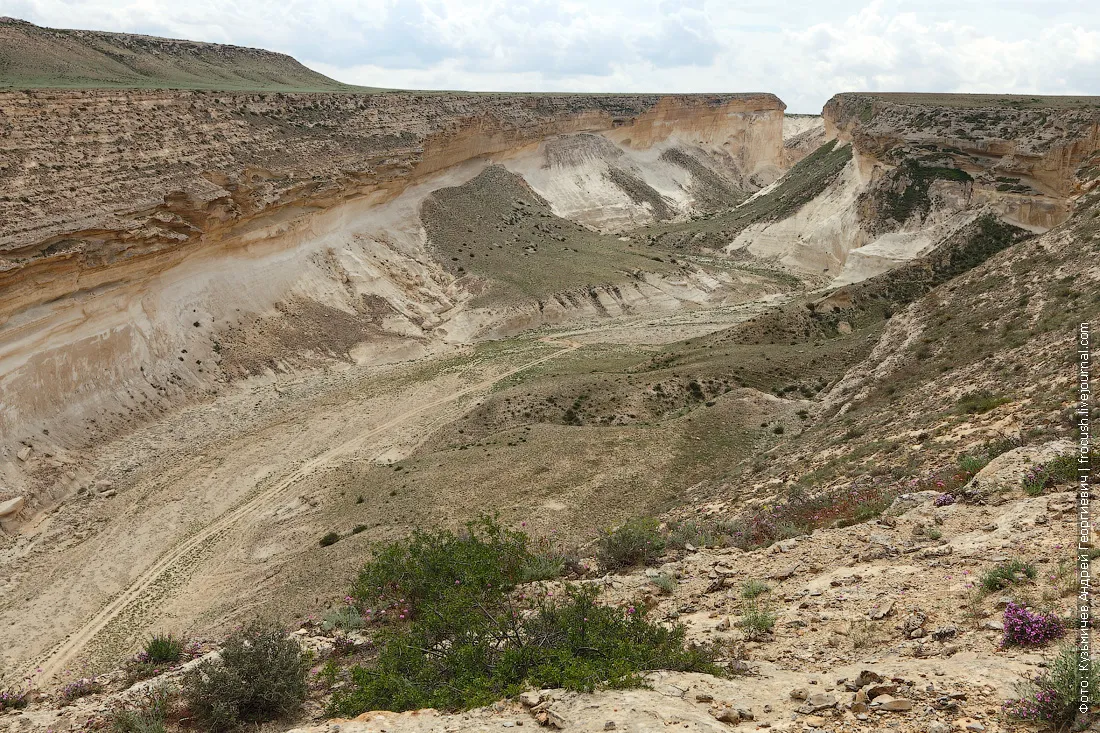
A spectacular and unusual spectacle opens before you, when you stand on top of the canyon.
36. 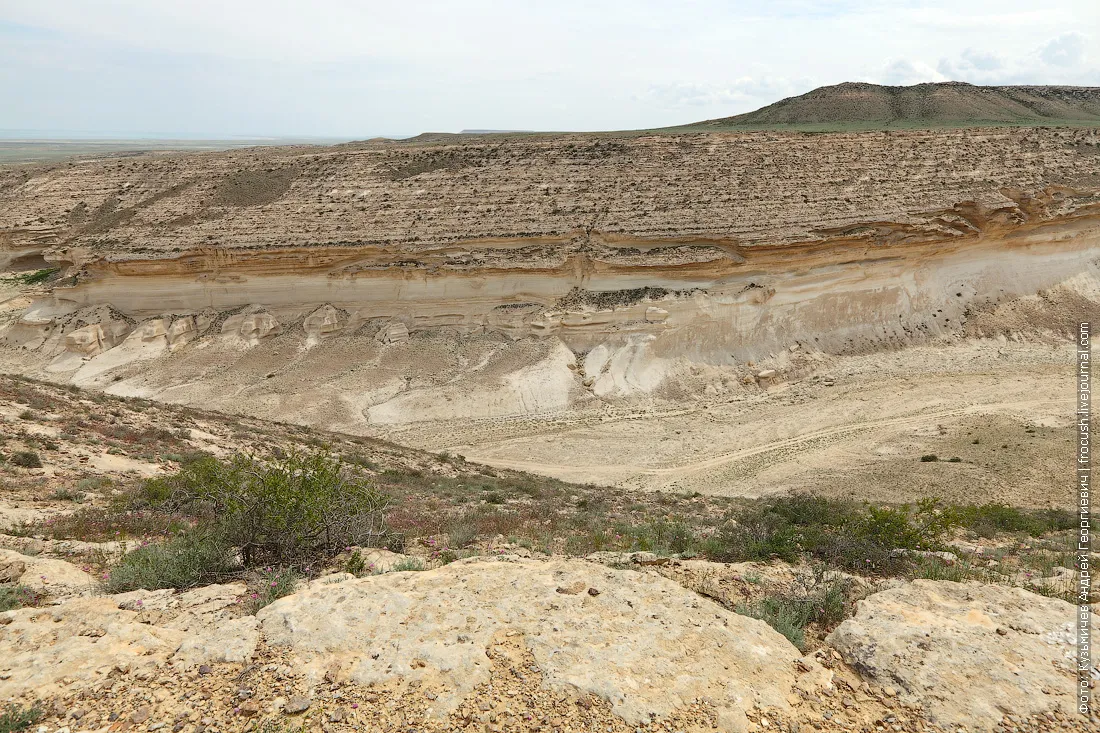
Vegetation is scarce,
37. 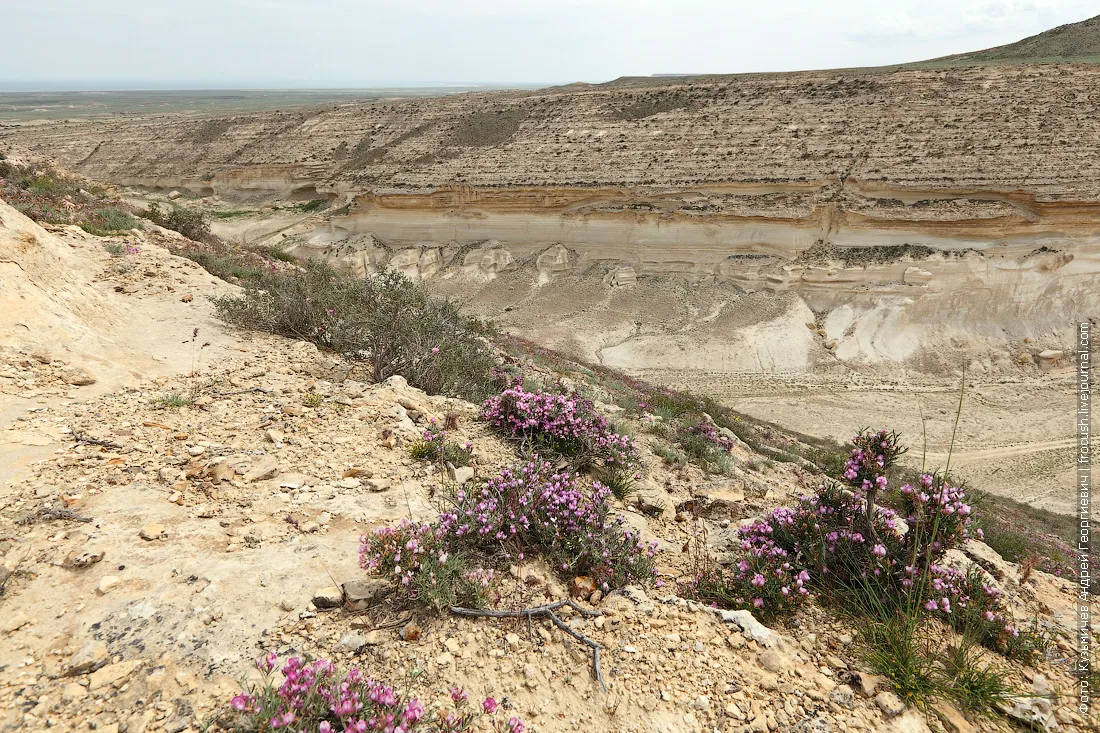
but beautiful.
38. 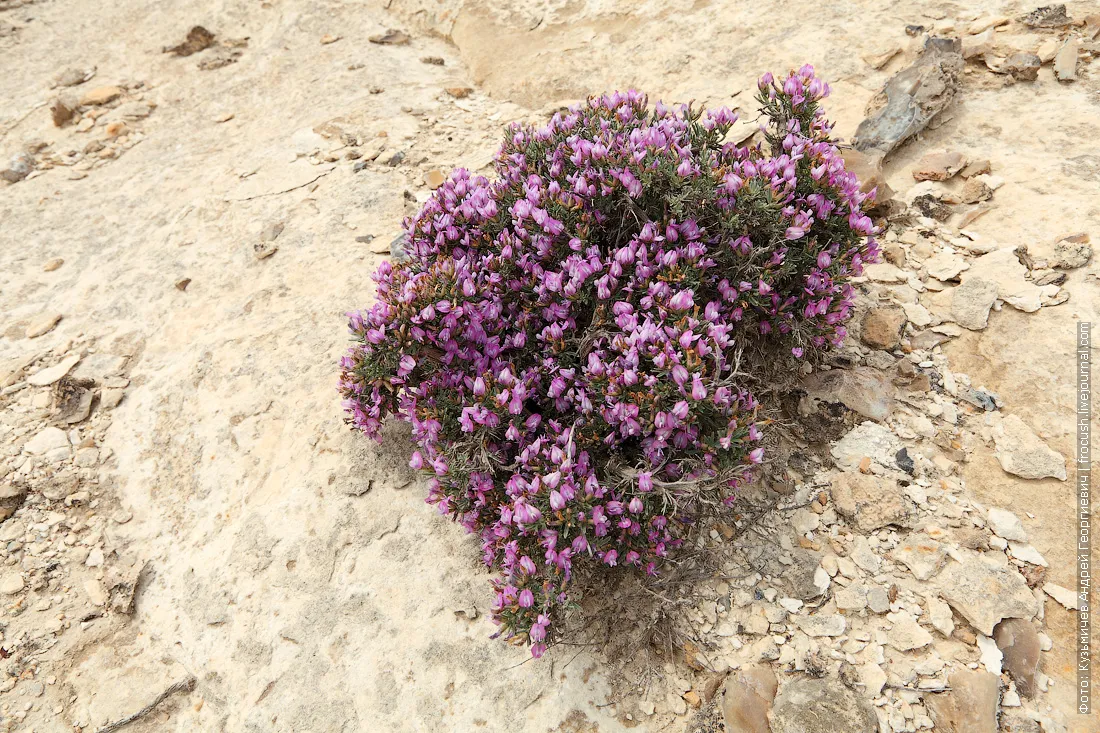
39. 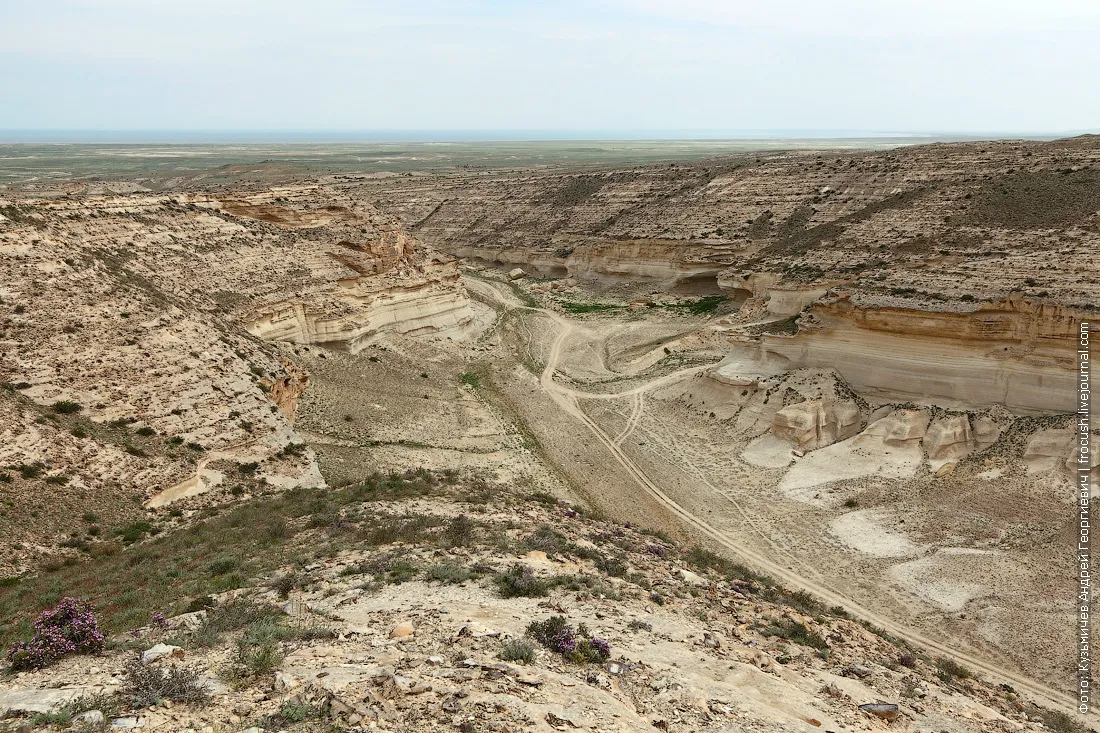
Tourists of the ship "Rus Velikaya" watch the canyon of Kapam-Sai.
40. 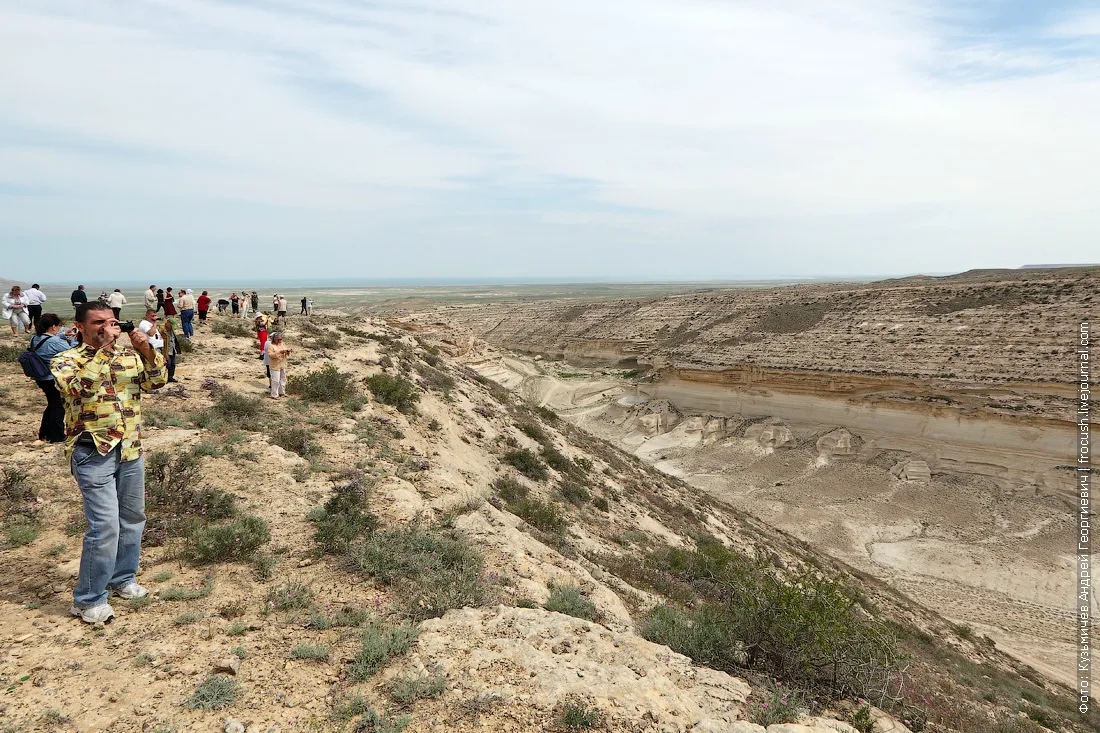
View from the edge of the canyon.
41. 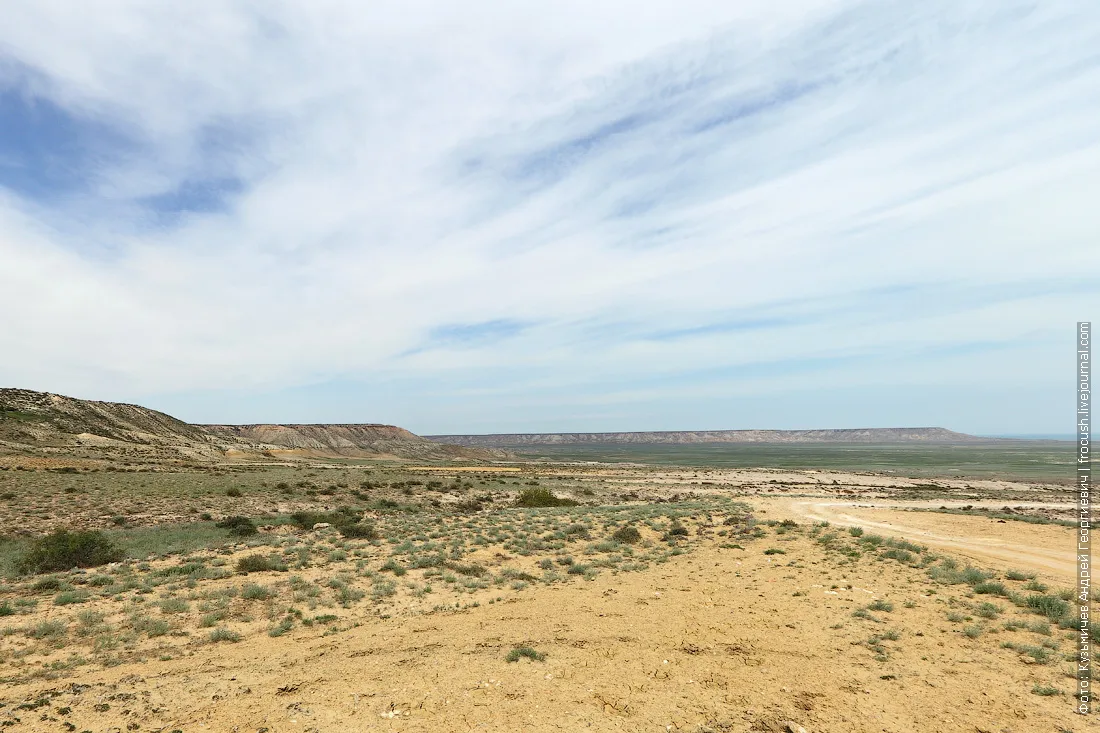
Another blossoming representative of the Kazakh flora.
42. 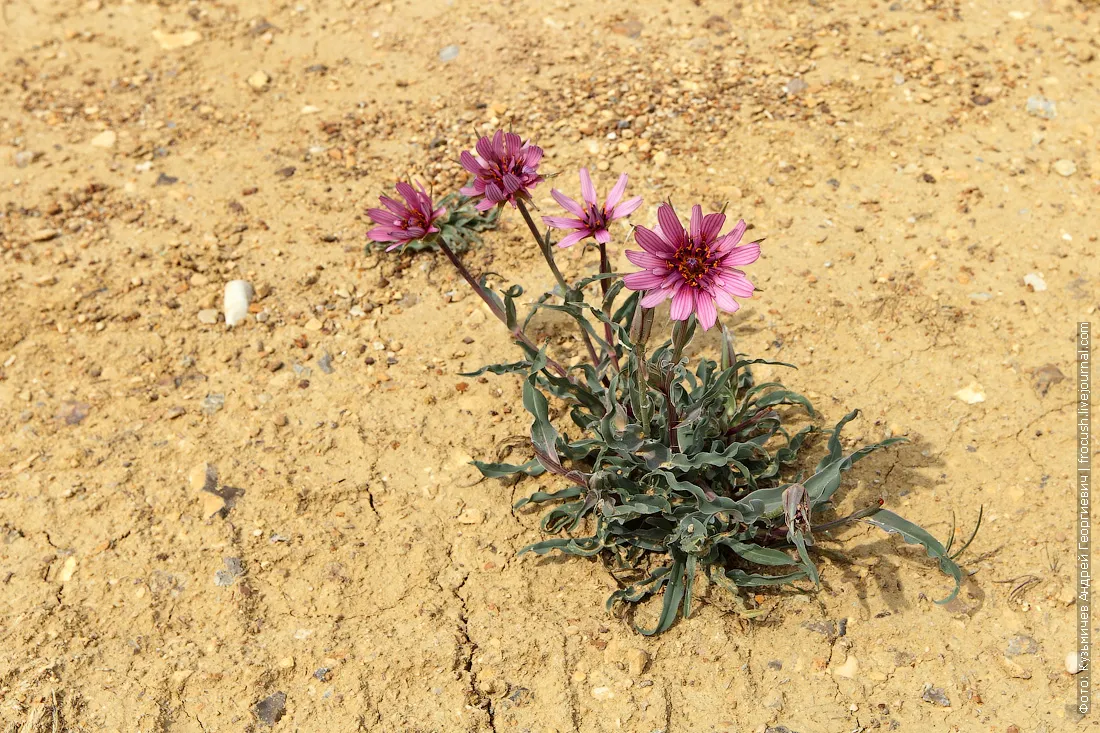
Before entering this small building, I just in case inquired about the purpose of this building. And then who knows! We have one thing, but here it may well be abroad that this is completely different. Once again to clarify - not superfluous. But it turned out to be the same as ours.
Then I liked something. I vividly imagined the process of building local dwellings: I went up to the rock, nailed myself stone blocks, folded the structure and everything. The house is ready.
By the way, in Mangistau, a natural decorative stone shell is mined. It can be found even in Moscow, for example, in the lining of the inner walls of the Soyuz Hotel.
43. 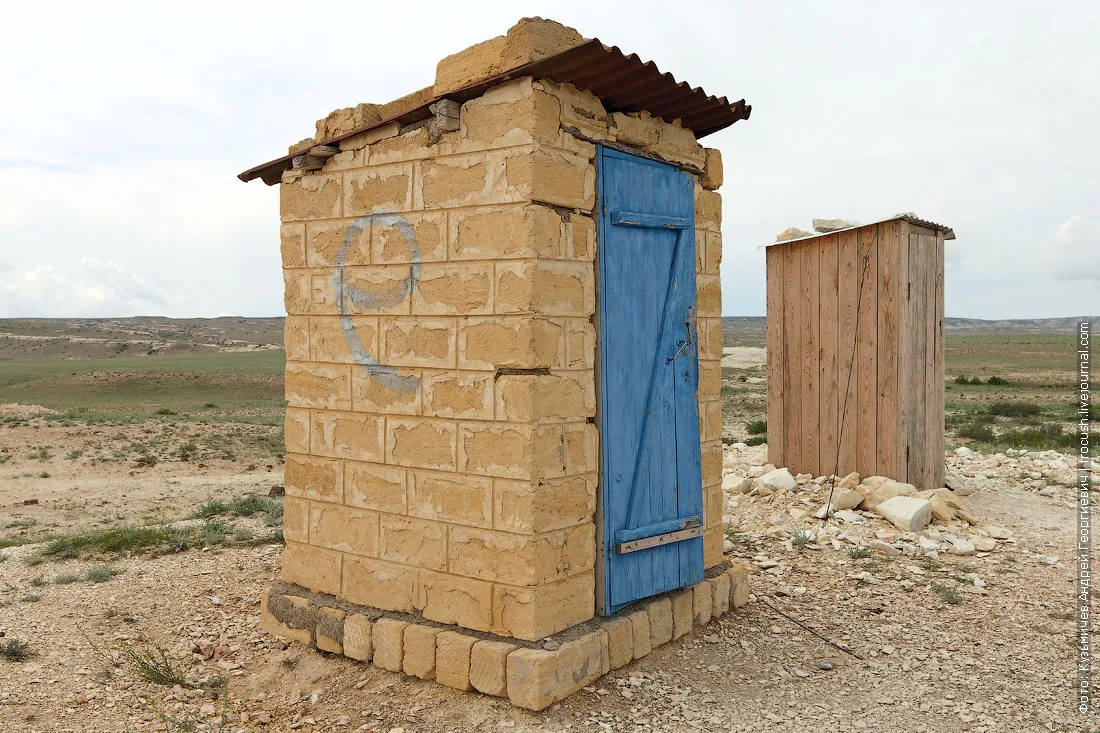
Then we waited for the underground mosque Shakpak-Ata, but first we visited the necropolis near it.
44. 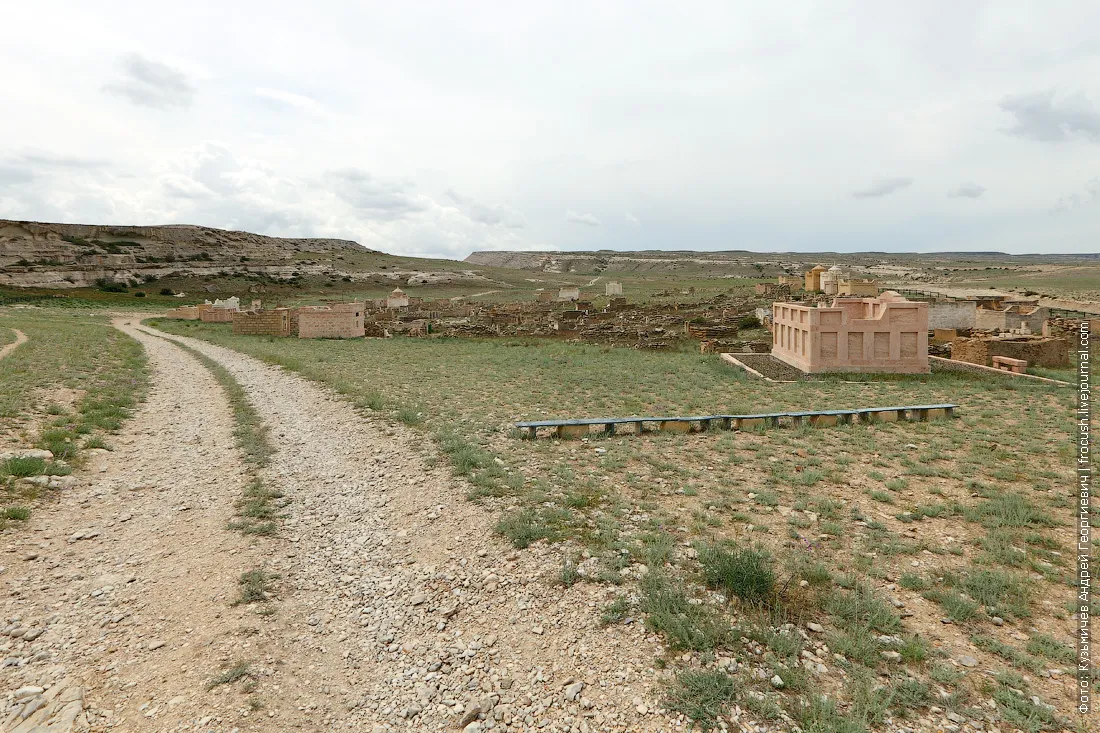
This Muslim cemetery is noteworthy for the fact that here there are gravestones of different epochs: from the most ancient (11th century) to modern.
On the photo: Saganatam (kheregetam) - a fence with a high front wall and a lancet opening in it.
45. 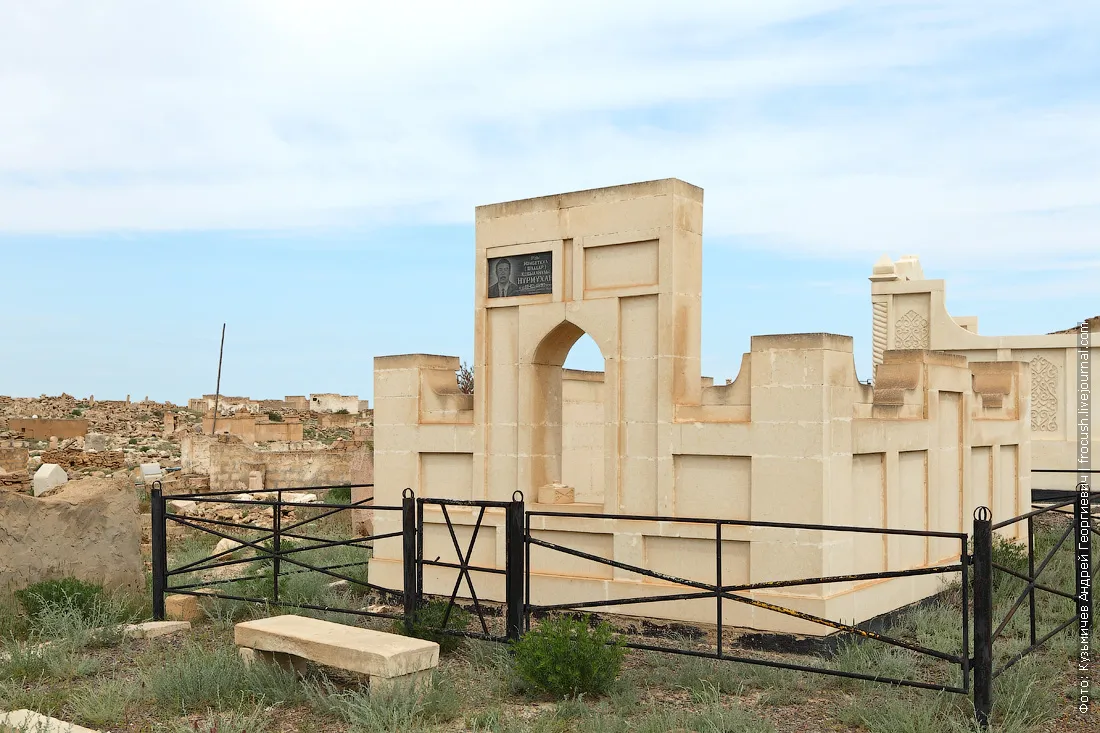
Tortkulak (four ears) - a square stone fence with small turrets on the corners, but without a high front wall. Four turrets at the corners of the fence carefully listen to all four directions of the world, i.e. Guard the peace of the deceased.
Inside one such fence, I looked.
46. 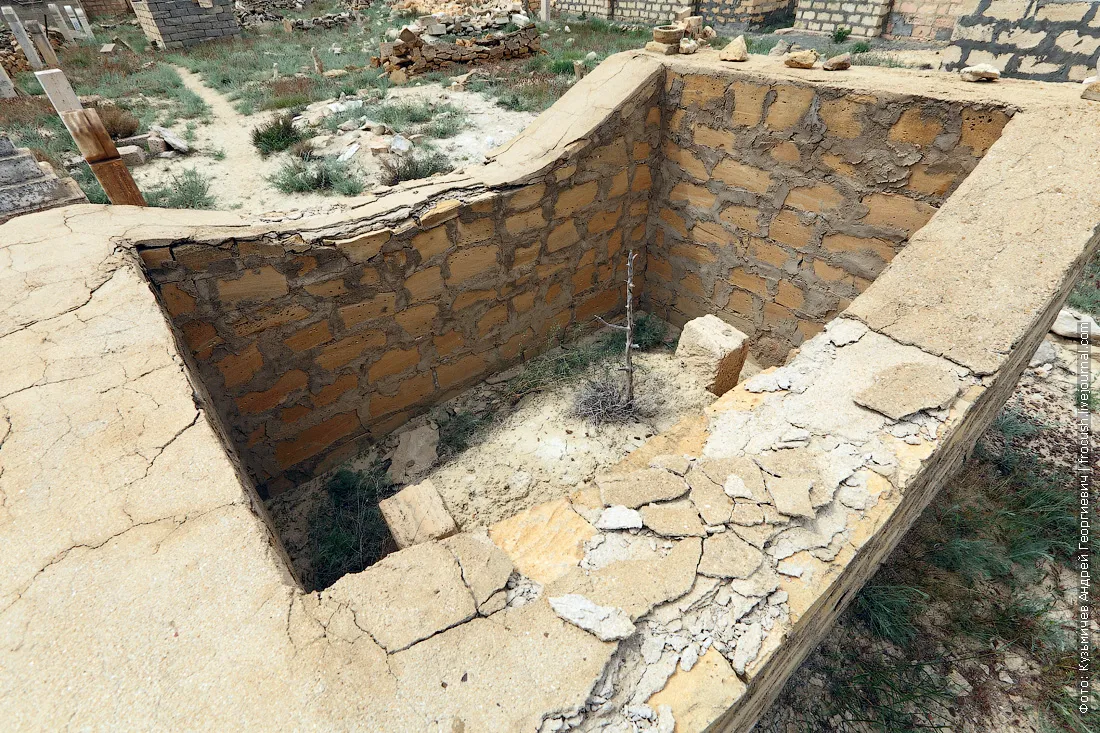
See a long wooden stick? This is not just a stick, but a channel for connecting the world of the deceased with the world of the living!
47. 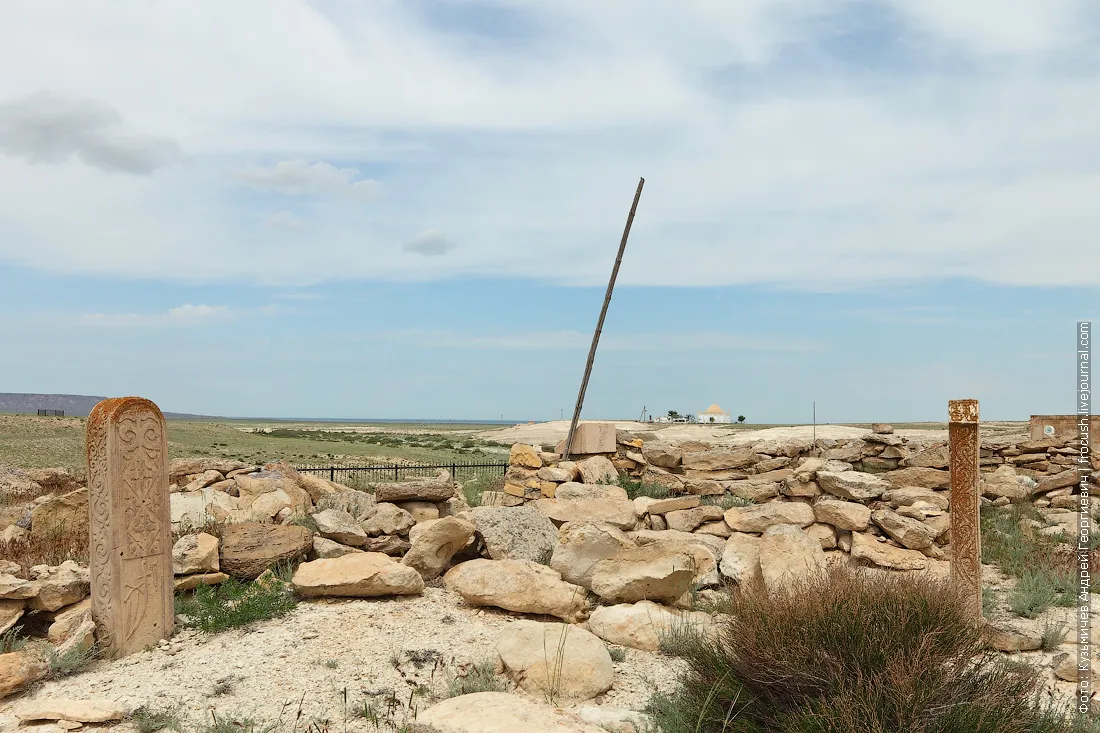
In the foreground are shown kulpitas (castle stones) - stone carved pillars dug at the head of the burial (on the west side). These kulpitas are very ancient, the time has erased all the carvings on the stone.
48. 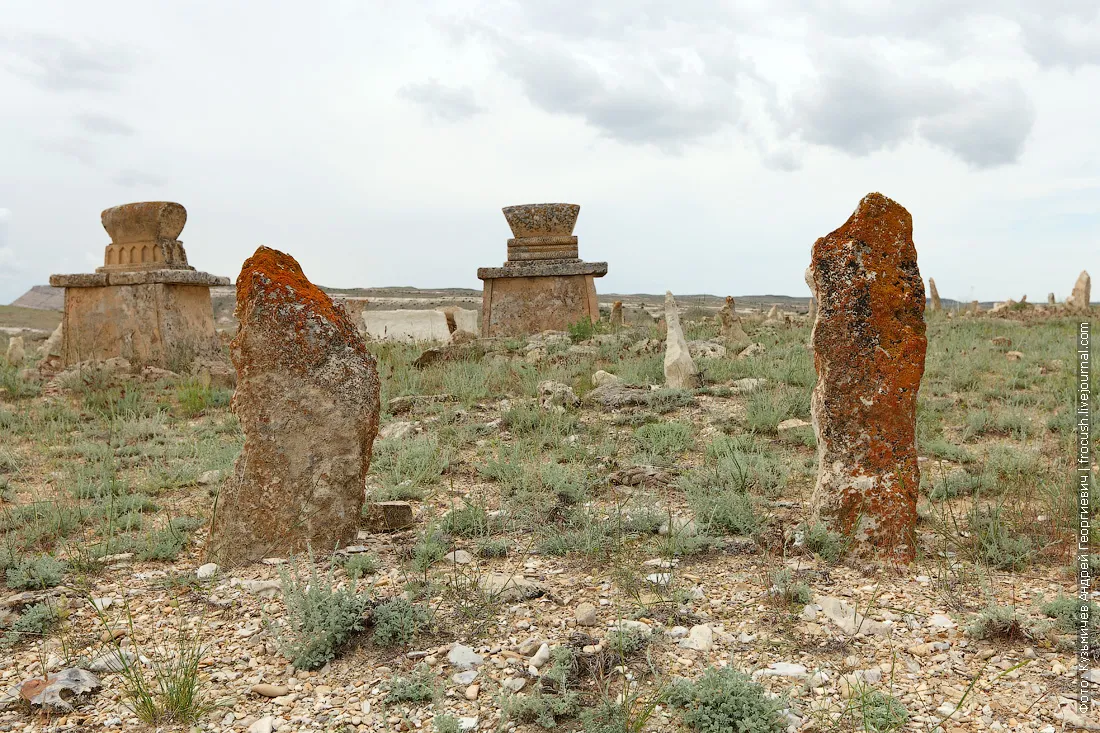
And these are more modern kulpitas installed at the burial place of the warrior and his wife.
49. 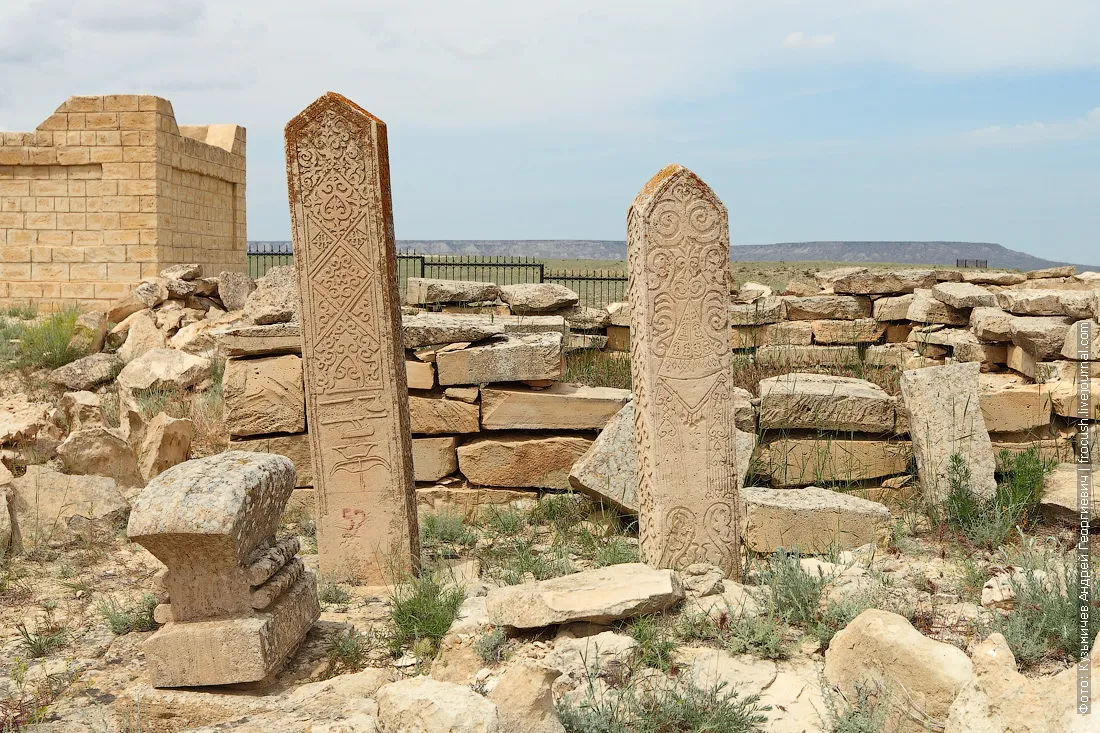
Sandyktas (a stone box) is a rectangular stone box covered with a massive stone slab. On the lid sandyktasa koitas (stone-ram) - a stone-carved tomb stylized as an image of a ram. These monuments also reflected the ancient cults of the ram as a totem of the genus, and the Muslim veneration of the lamb as a sacrificial animal, and nomadic ideas about a male warrior who brings his life on the battlefield for sacrifice for the sake of honor and freedom, for the sake of his native land and people.
50. 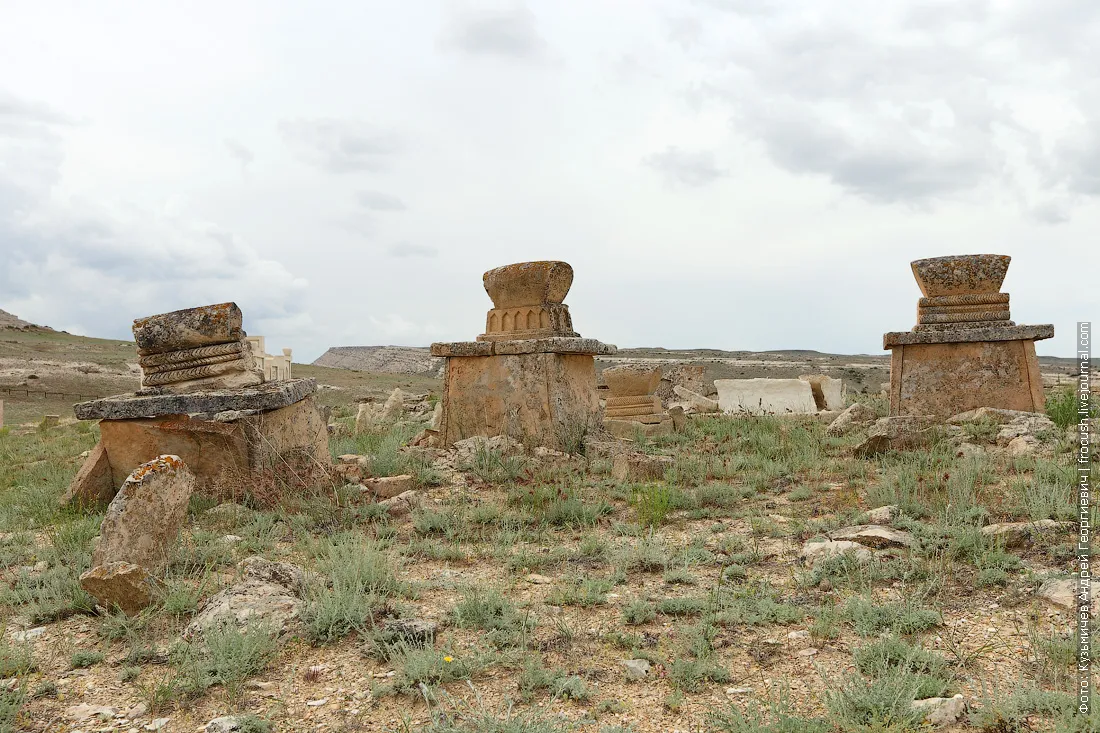
Saganatams. It is not customary to take care of burials. They buried a man, put a tombstone on the grave site and everything. Now the tombstone will destroy time - turn into dust. Those. A man came from the dust and there must return.
51. 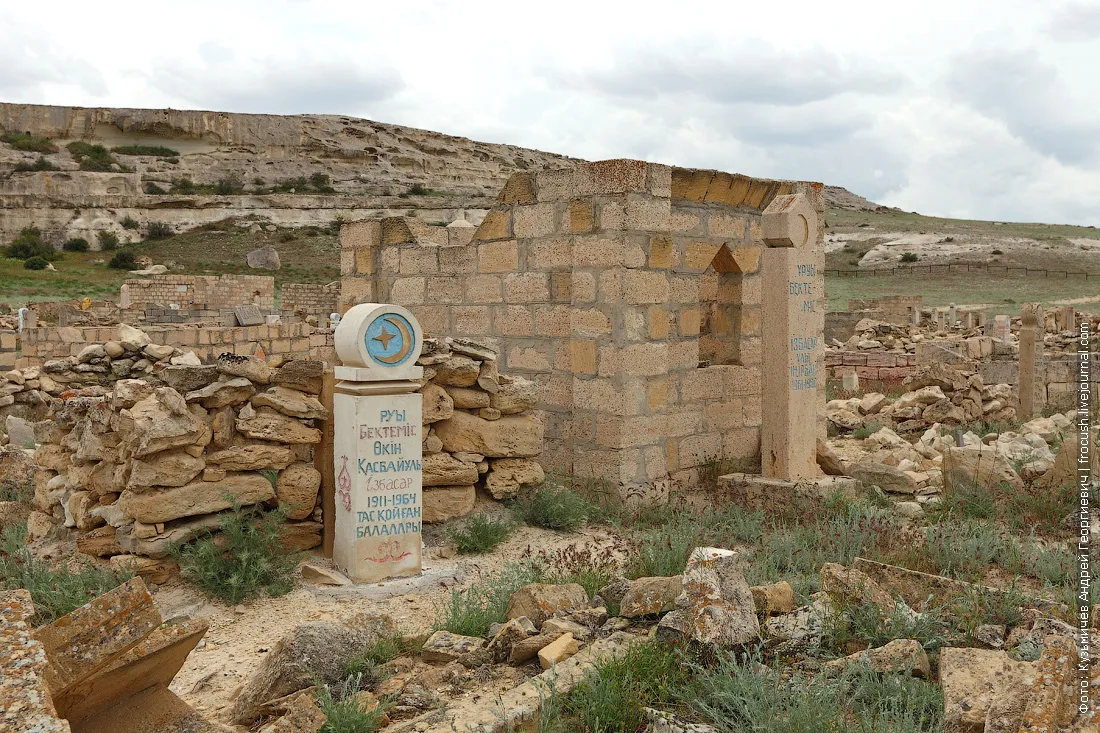
Saganatams.
52. 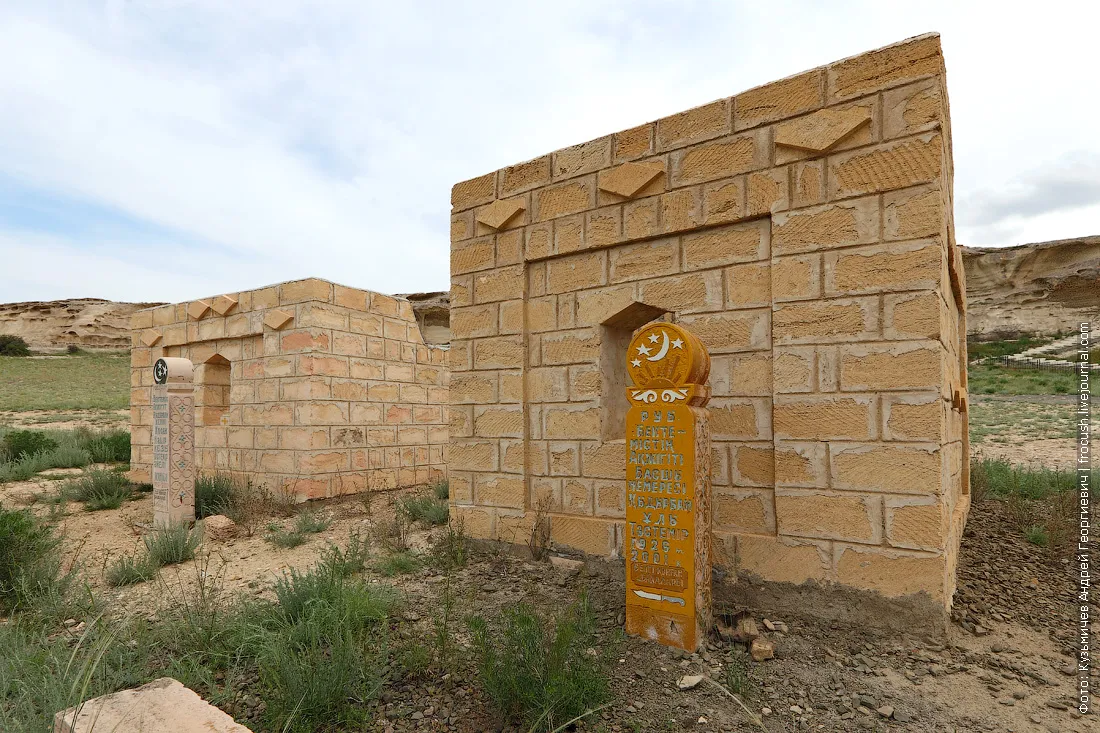
Right on the photo: dome mausoleum (kumbeztam).
53. 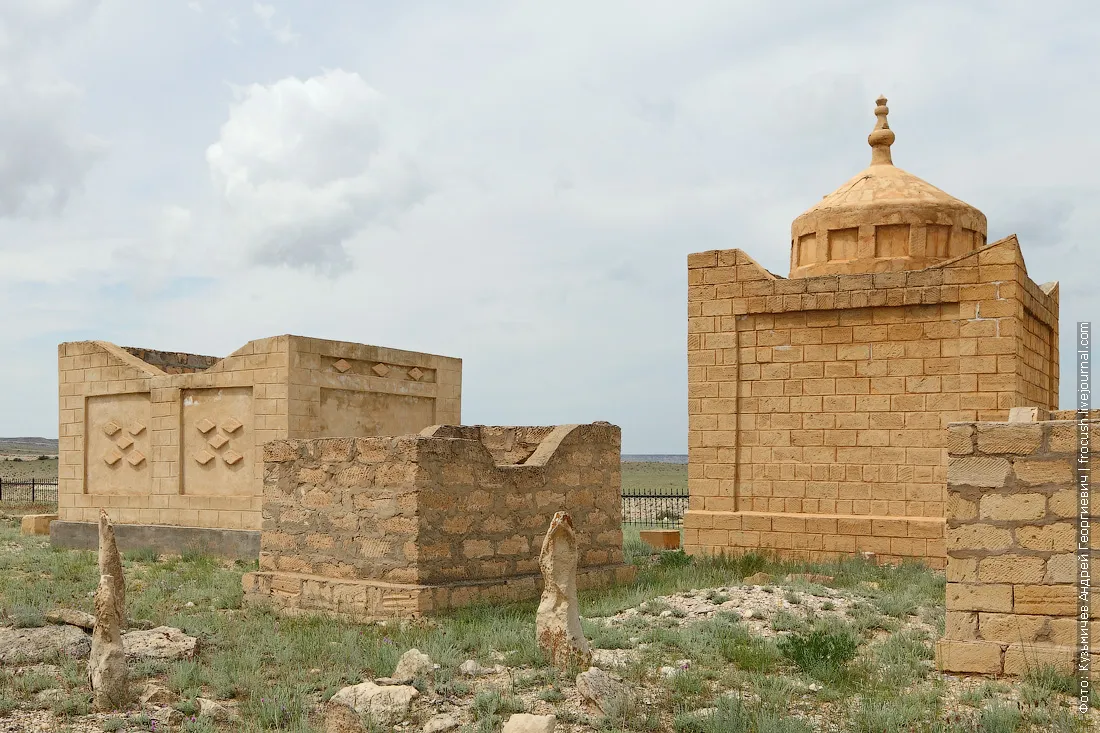
Necropolis of Shakpak-Ata.
54. 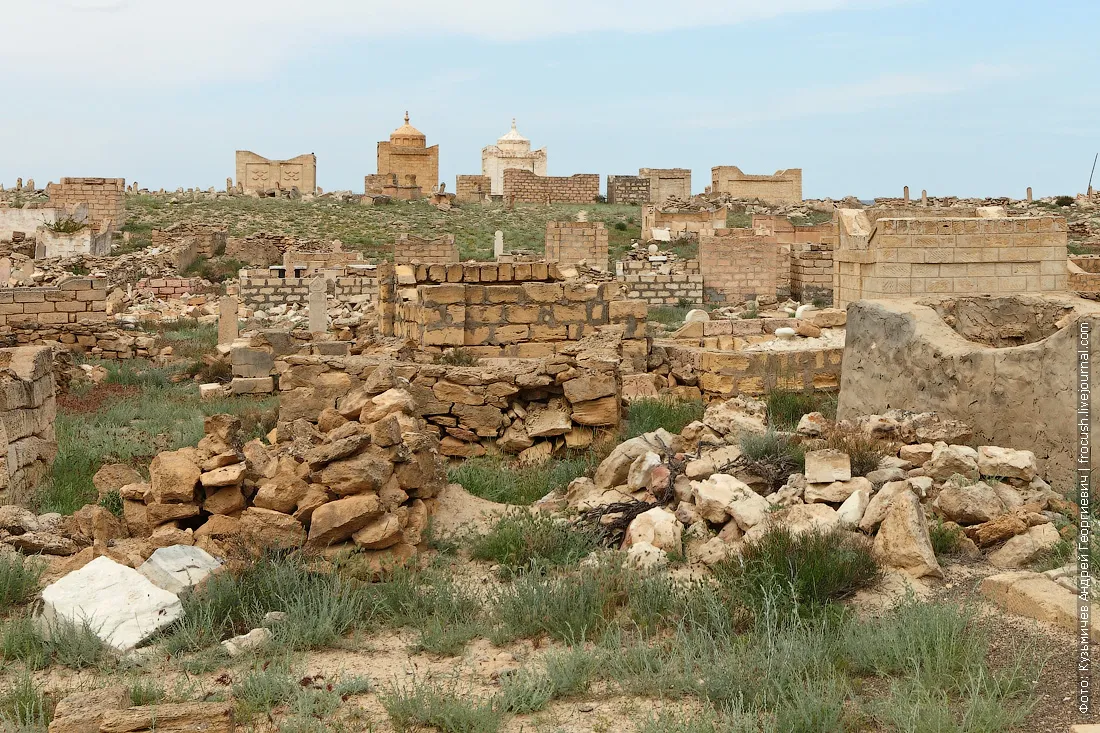
And now we'll go to the Shakpak-Ata underground mosque. It is named after Sufi Shafpak-Ata, one of the 360 revered saints in Mangistau, who, together with his disciples, hid in this cave and practiced healing magic. It was in the IX century!
55. 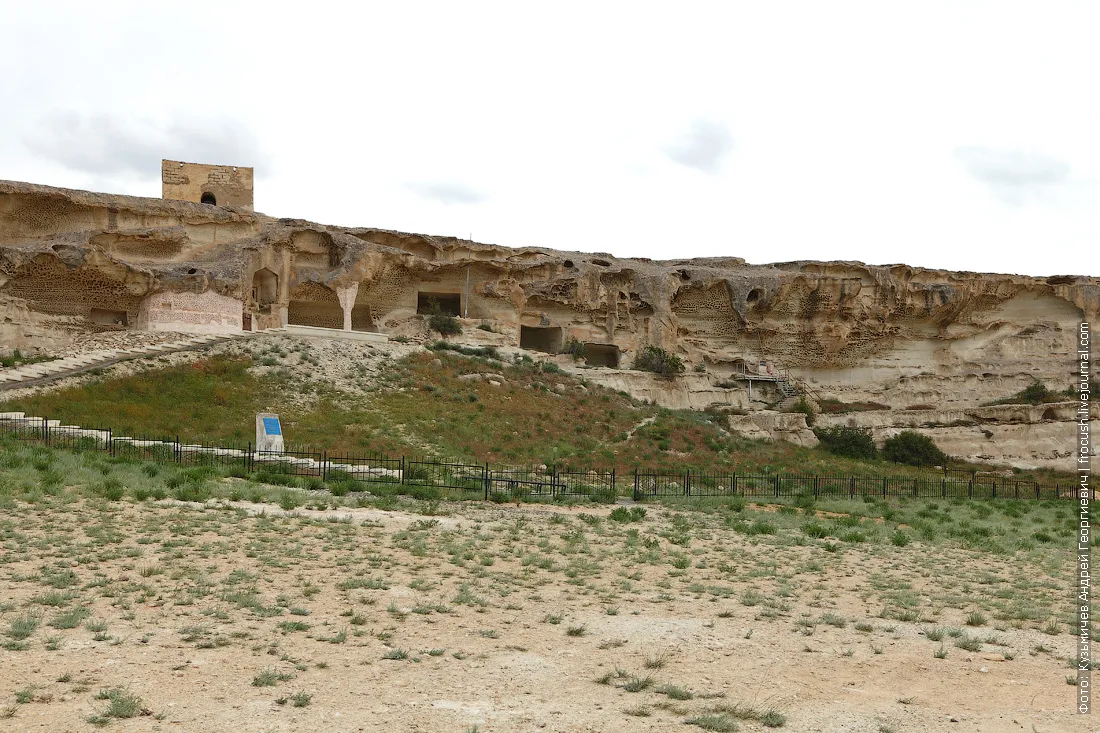
On the way we find a turtle. Of course, a curiosity. It is necessary to take a picture! But then we had a lot of these turtles, and we even stopped paying attention to them.
56. 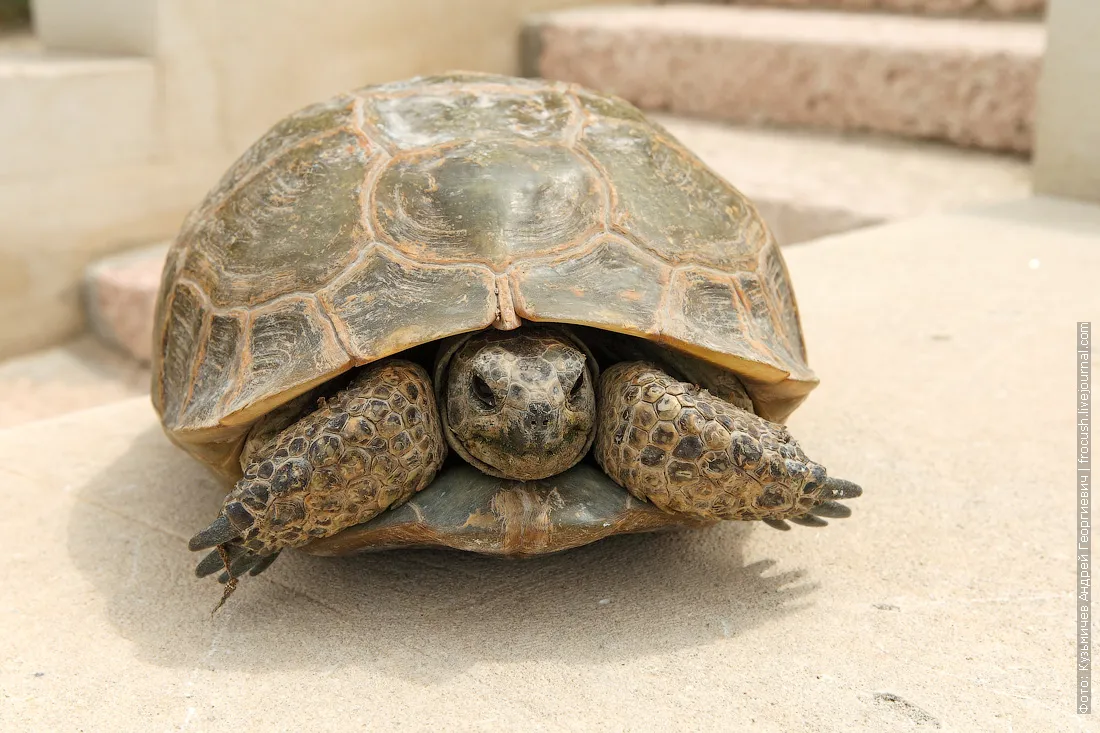
View of the Shakpak-Ata necropolis from the underground mosque.
57. 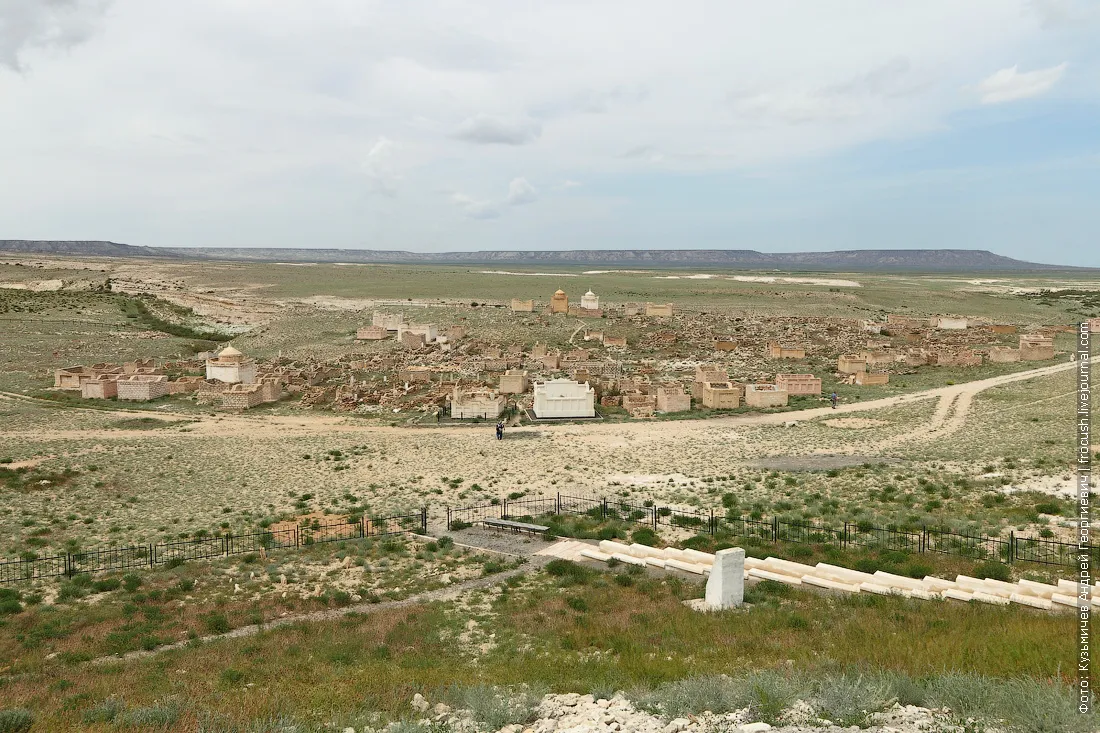
On both sides at the entrance to the mosque in the rock are carved caves-burial places, they belong to the pupils of Shakpak-Ata and people close to him.
58. 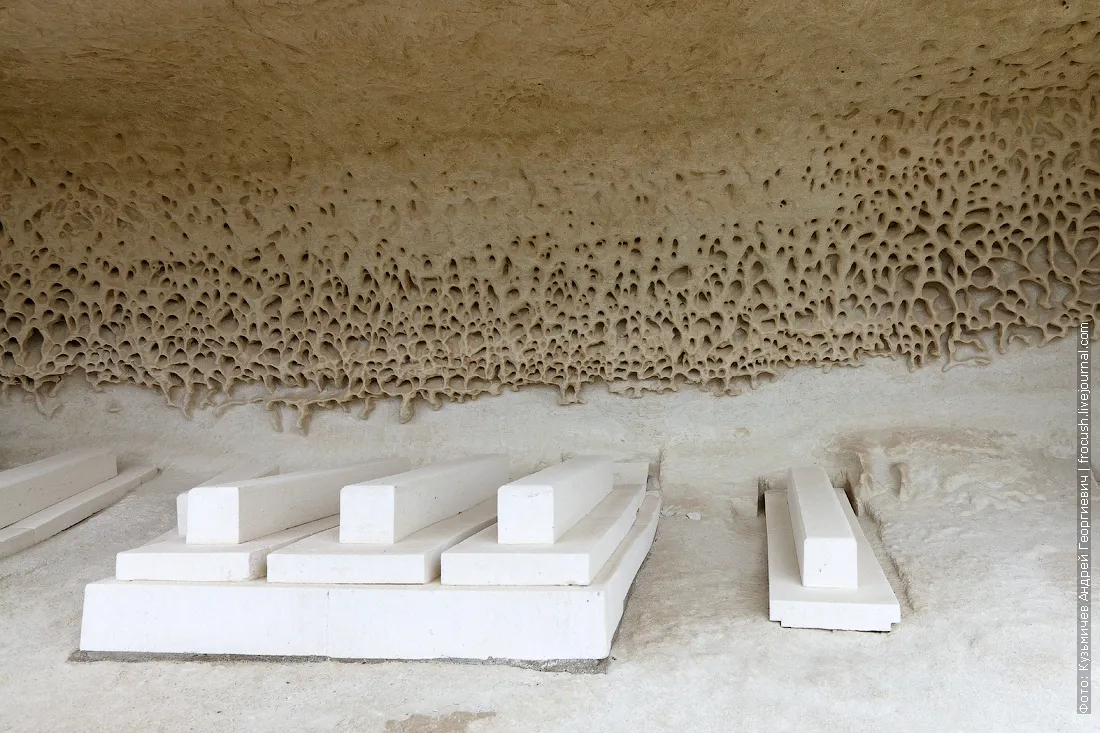
The Shakpak-Ata underground mosque was cut down in a mountain chalk cliff. By the way, the historical entrance to the mosque was not here, but a little higher. There's a window right now.
59. 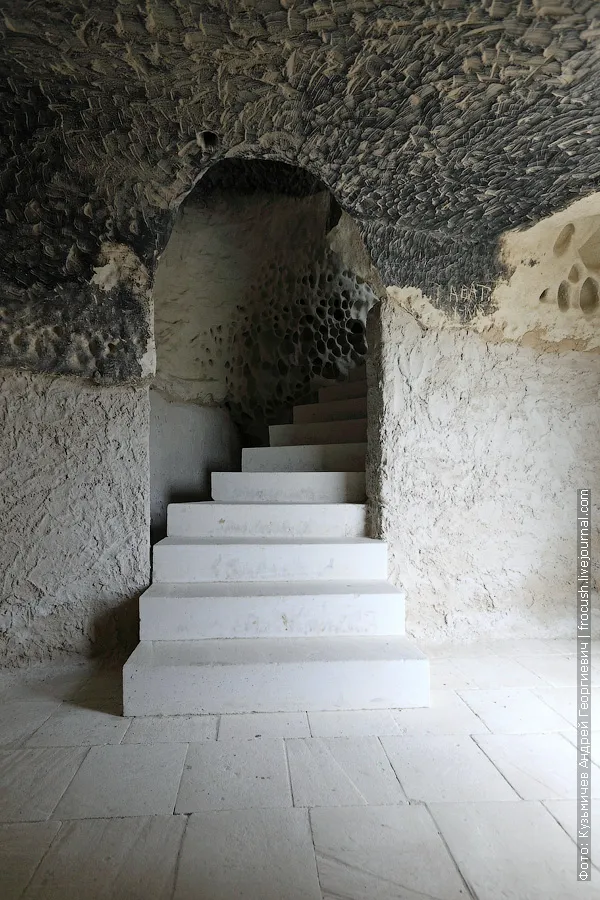
The form of the mosque plan, as well as other architectural details, indicate the belonging of the building to the 9th-10th centuries. The mosque is strictly oriented around the world, cut down in limestone rock and consists of four chambers, being thus a kind of variant of the cross-domed temple, which has four columns with capitals. The domed structure imitates the construction of the yurt, and in its center a round window is cut.
60. 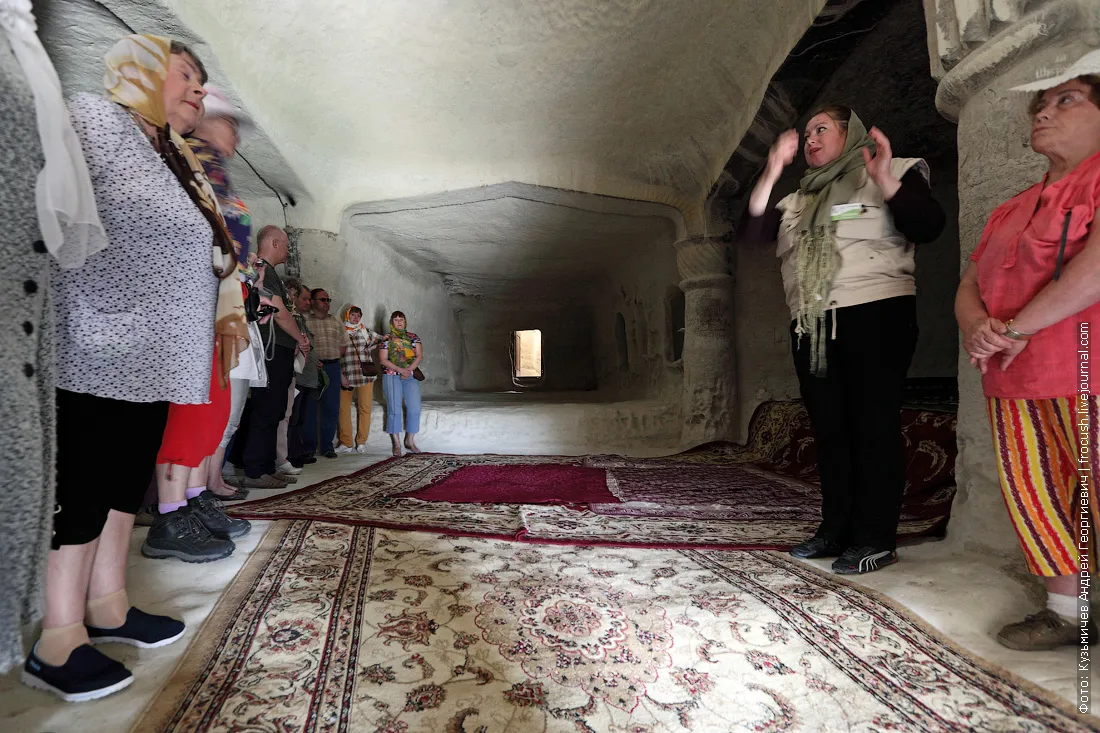
Some scientists claim that the main purpose of this sanctuary is healing. It is not excluded that the ministers of this place were some kind of monastic order, treating patients. One of the tourists of the ship approached the column, in which they ask for blessings and fulfillment of desires.
61. 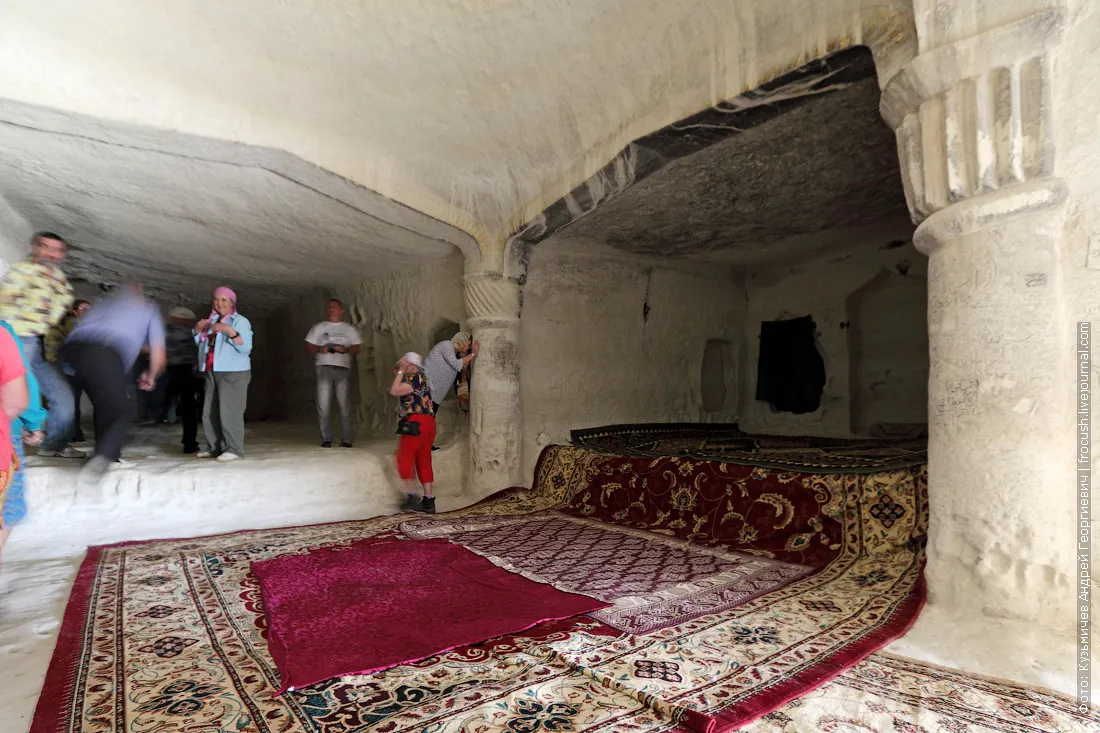
At the moment, the possibility to include Shakpak-Ata in the UNESCO World Heritage List is being considered.
By the way, during all excursions we were accompanied by a doctor of the ship "Rus Velikaya" with a medical suitcase.
62. 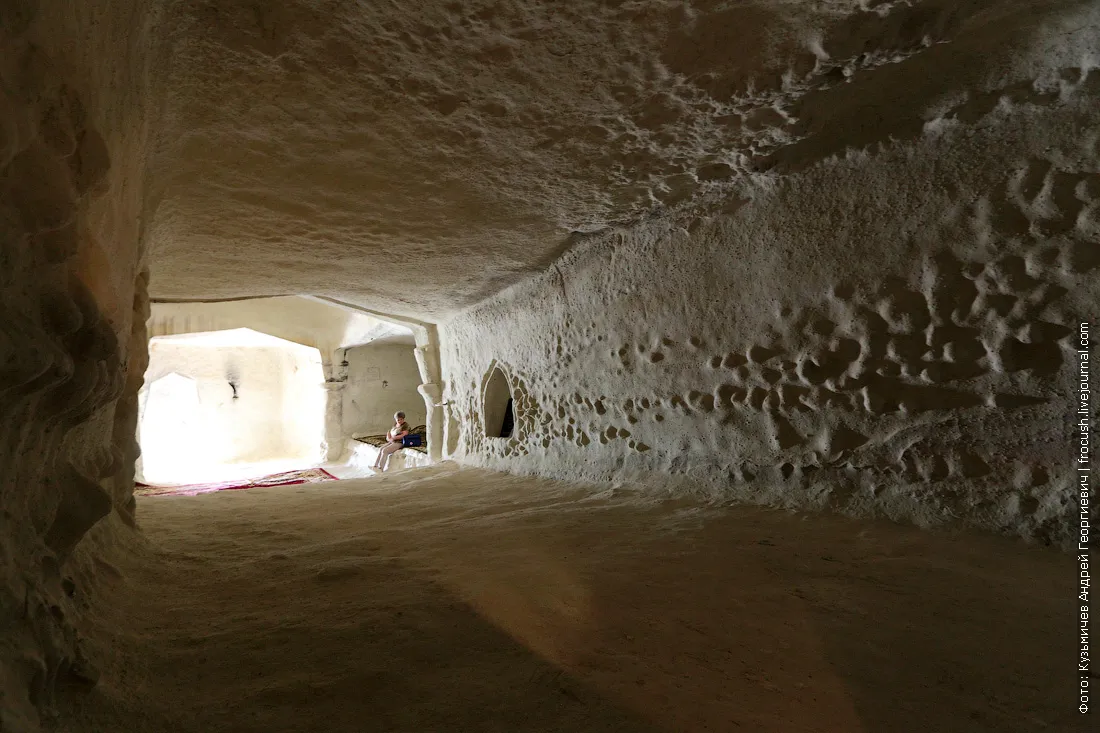
We leave to the top.
63. 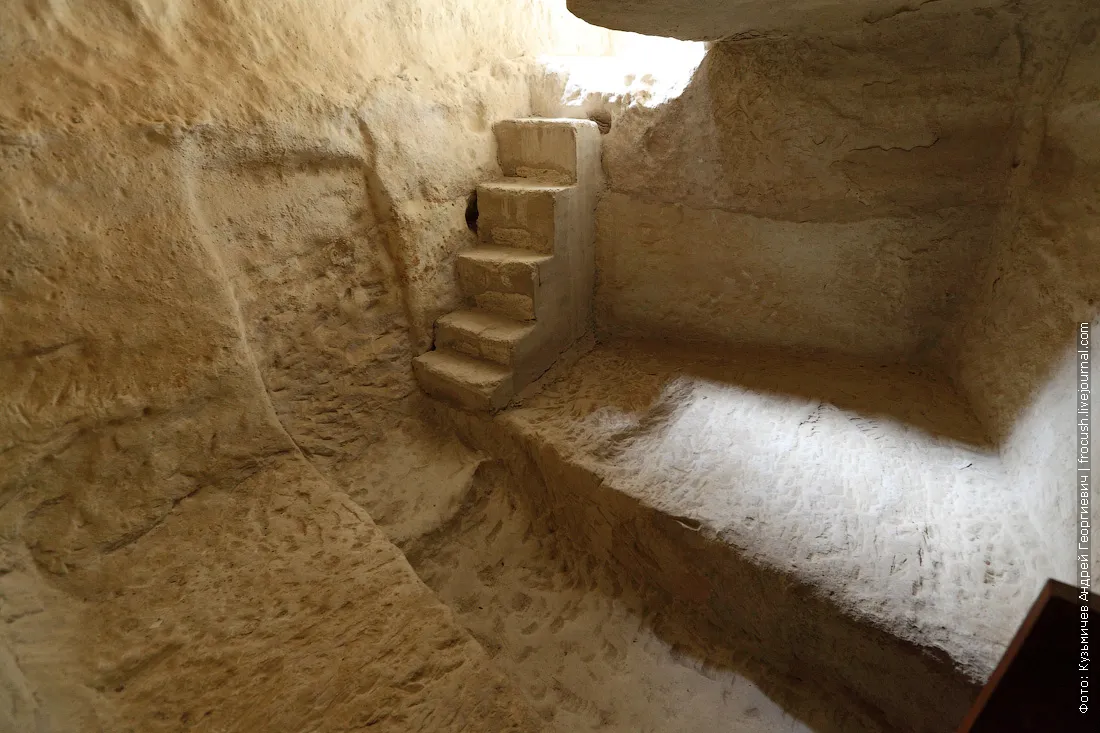
Above, almost nothing reveals that there is an underground mosque in the rock. In the IX century Muslims were not easily here, they had to hide and build cult buildings underground.
64. 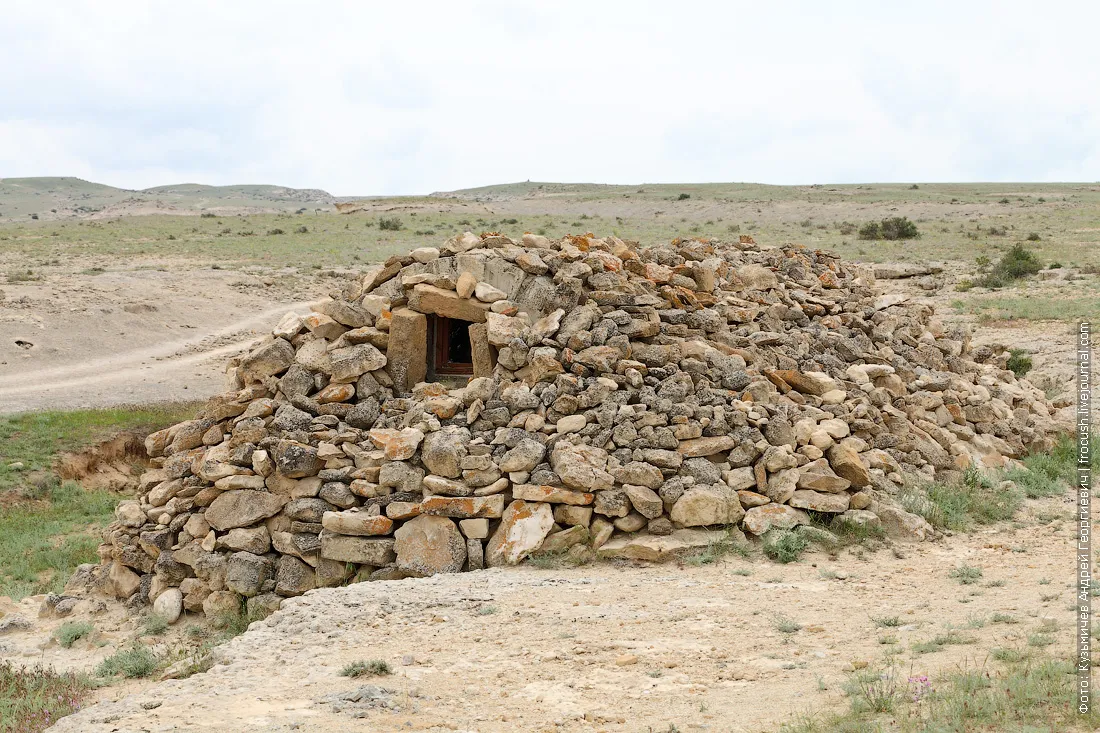
Not far from the underground mosque for pilgrims and travelers there is a guest house. Near to it our sightseeing buses stopped, and we went to inspect the necropolis and underground mosque of Shakpak-Ata.
65. 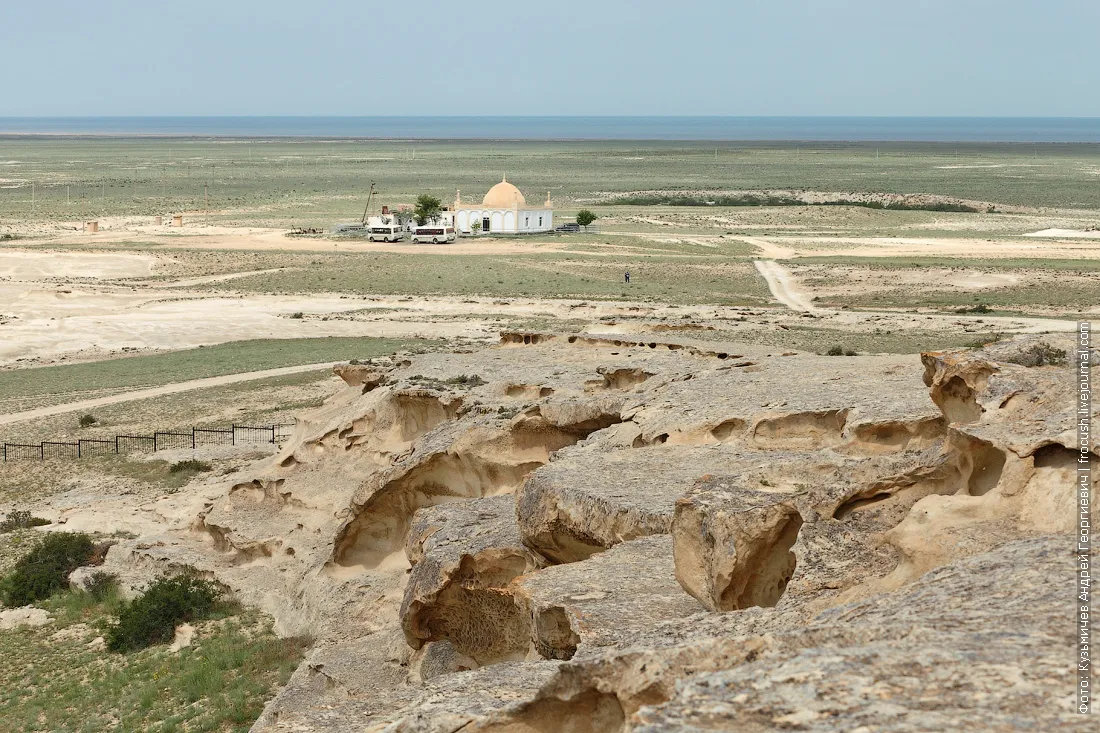
What amazing cavities for many, many years, washed the water in a chalky rock.
66. 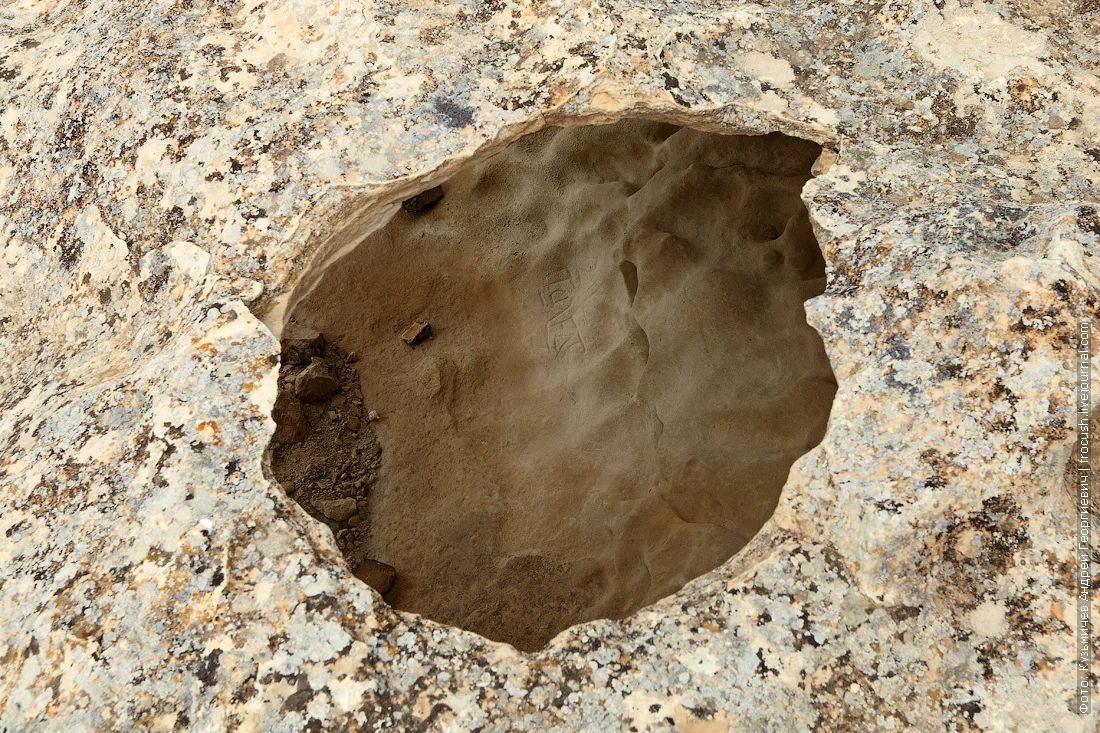
Look at the necropolis of Shakpak-Ata from the top of the chalk cliff.
67. 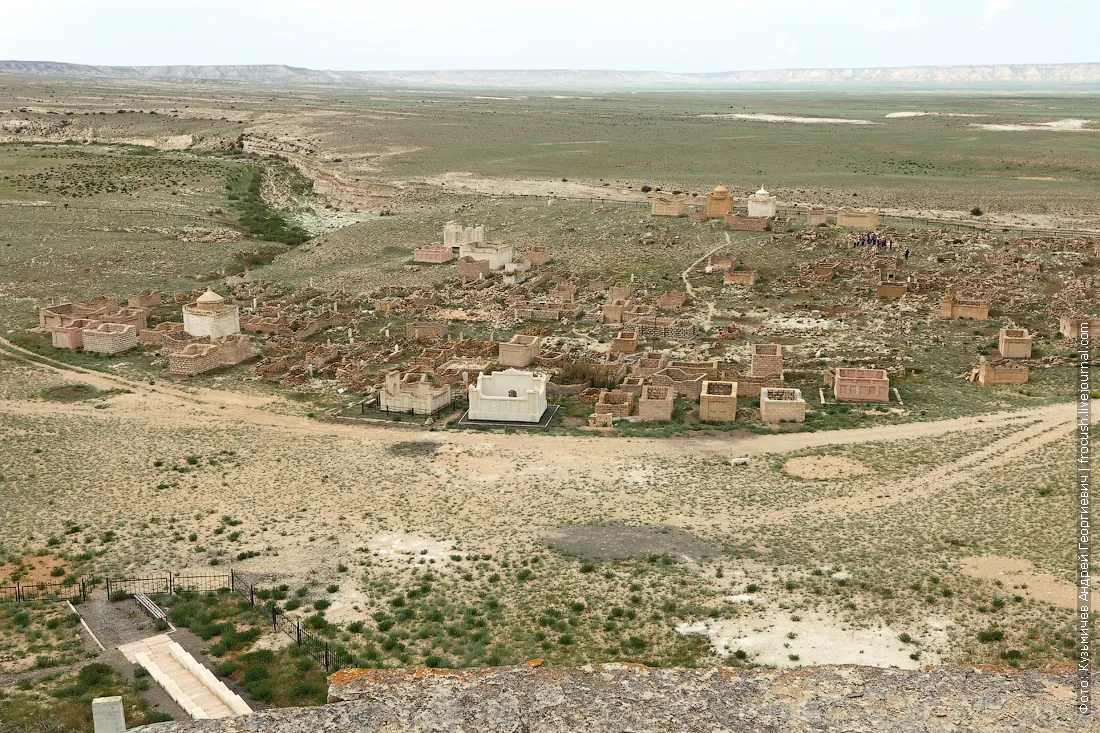
Neighborhood.
68. 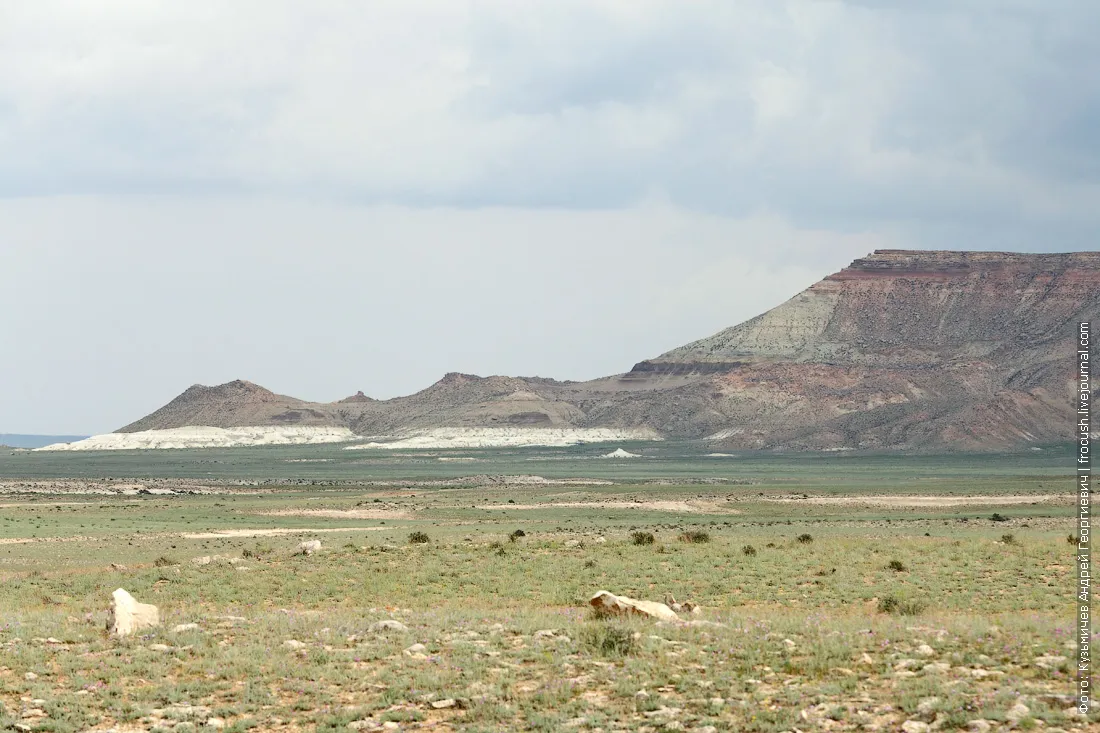
69. 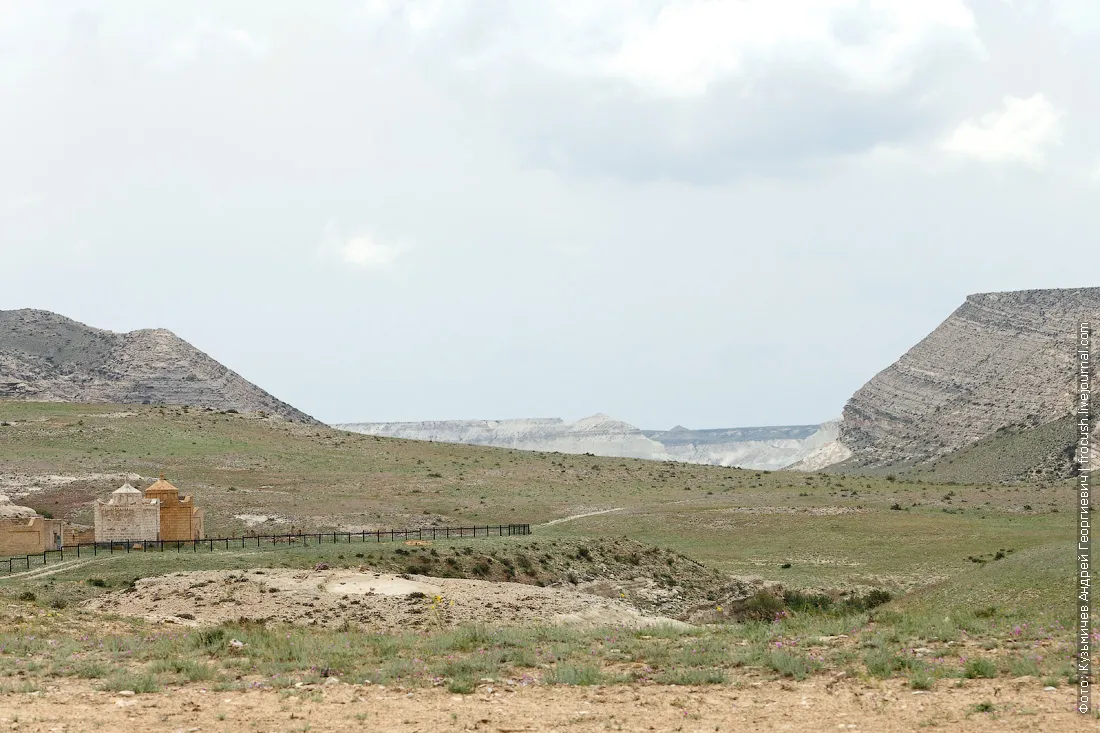
Guest House. There is everything you need for a short stay: there is where to sleep, where to cook food, eat, where to wash.
70. 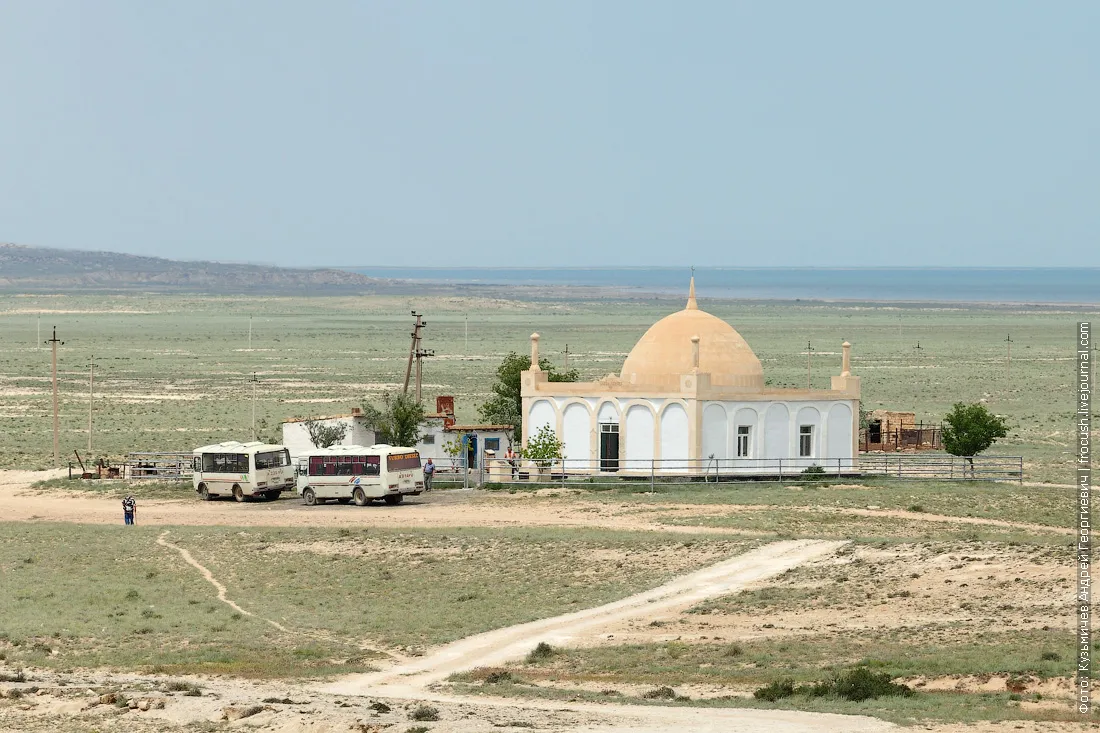
71. 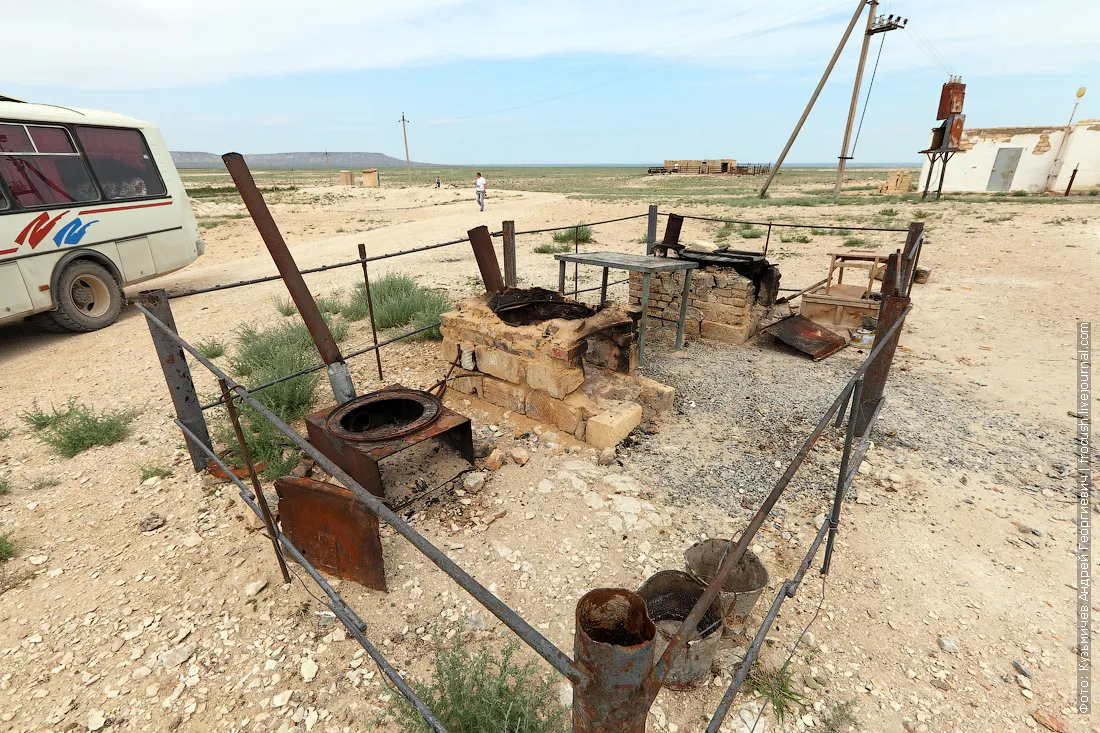
72. 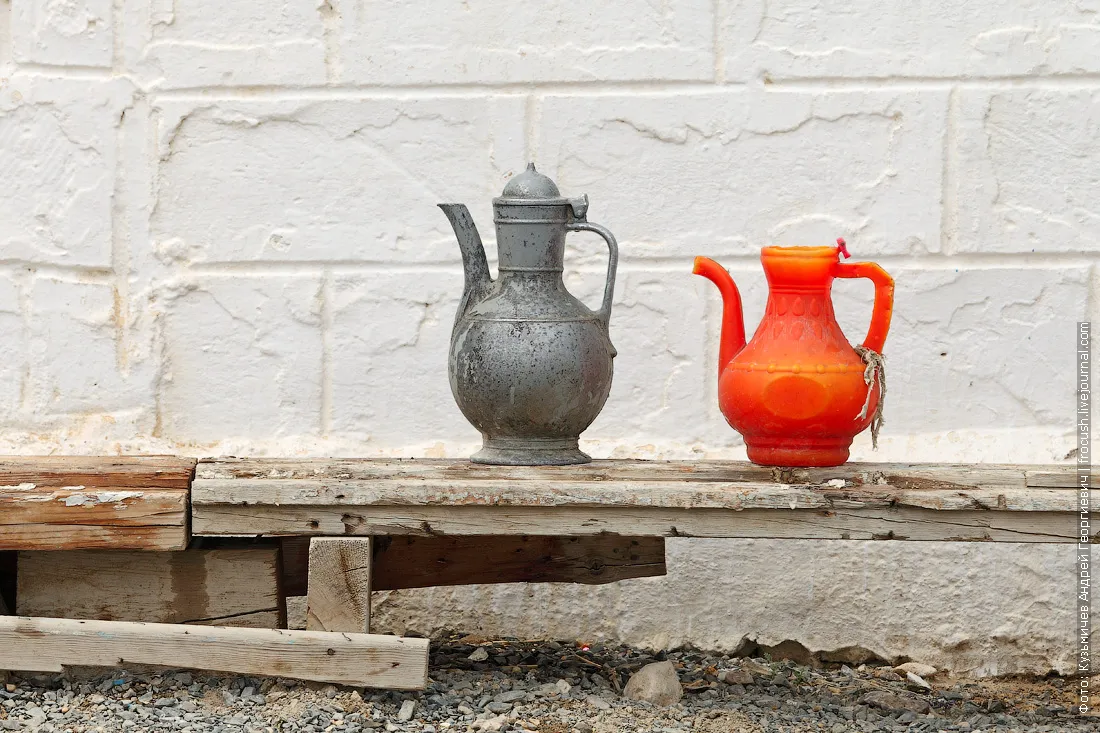
After getting acquainted with the underground monument of iconic architecture, we plunged into buses and moved to the terrain with an absolutely fantastic landscape: we arrived in the valley of the Torish stone balls.
73. 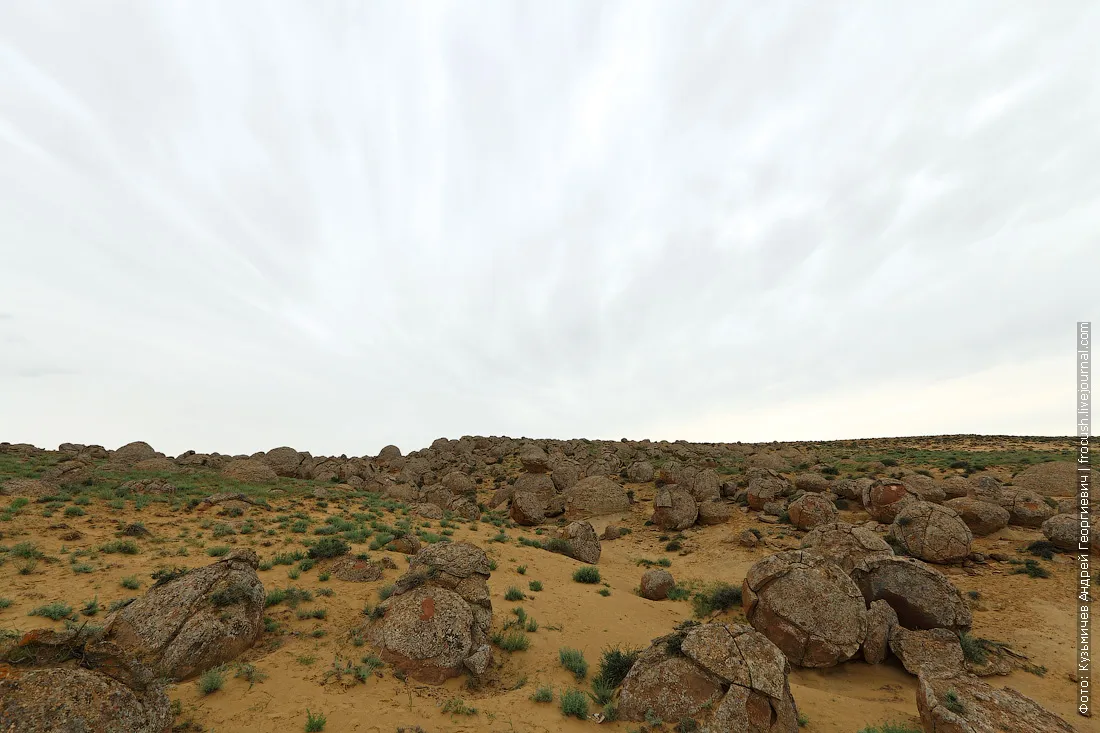
Vote for my post and subscribe to my blog @frocush!
Find me! LiveJournal | Facebook | Instagram